The Sydney Morning Herald
VerifiedAdded on 2022/08/25
|19
|5066
|9
AI Summary
Contribute Materials
Your contribution can guide someone’s learning journey. Share your
documents today.
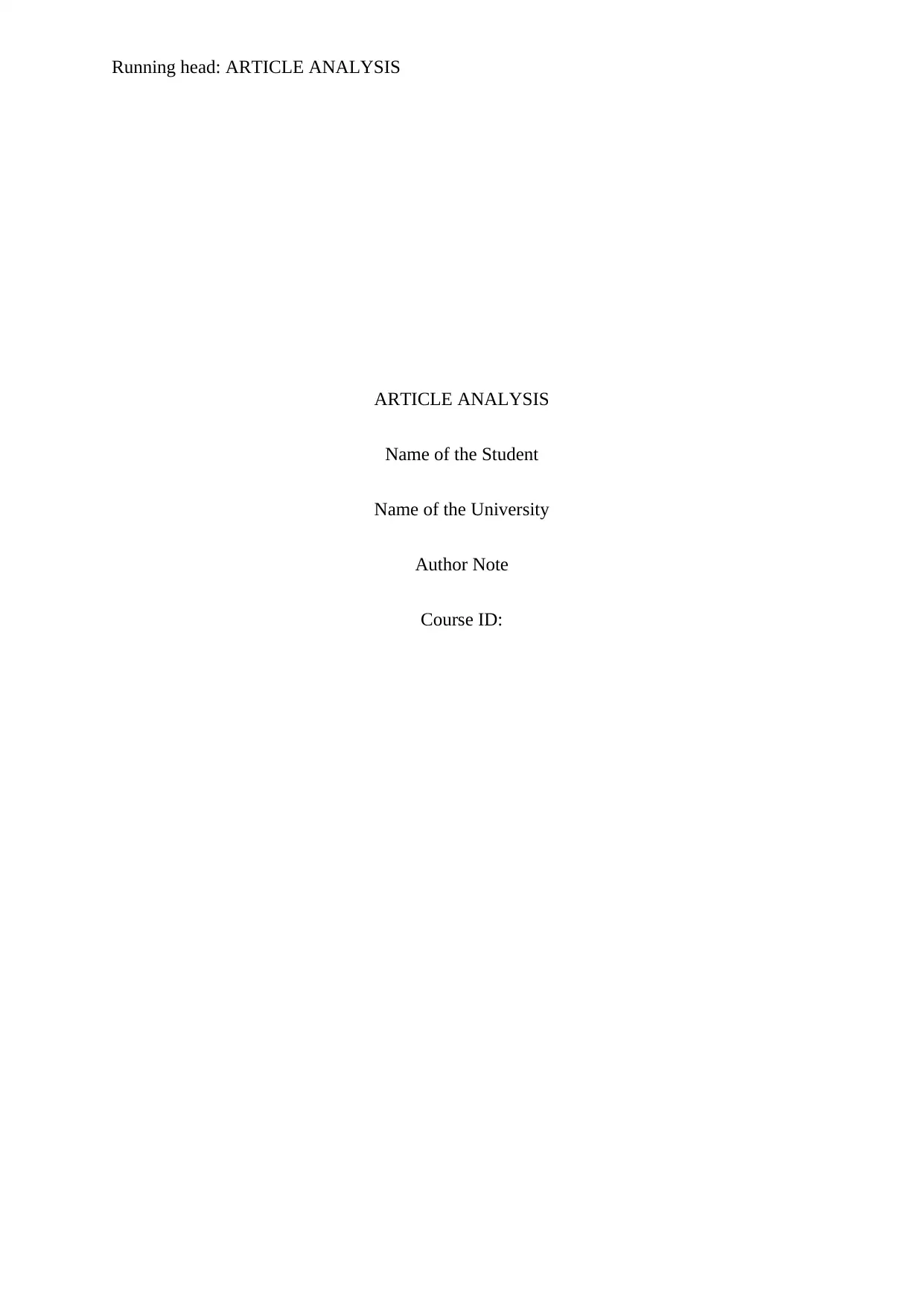
Running head: ARTICLE ANALYSIS
ARTICLE ANALYSIS
Name of the Student
Name of the University
Author Note
Course ID:
ARTICLE ANALYSIS
Name of the Student
Name of the University
Author Note
Course ID:
Secure Best Marks with AI Grader
Need help grading? Try our AI Grader for instant feedback on your assignments.
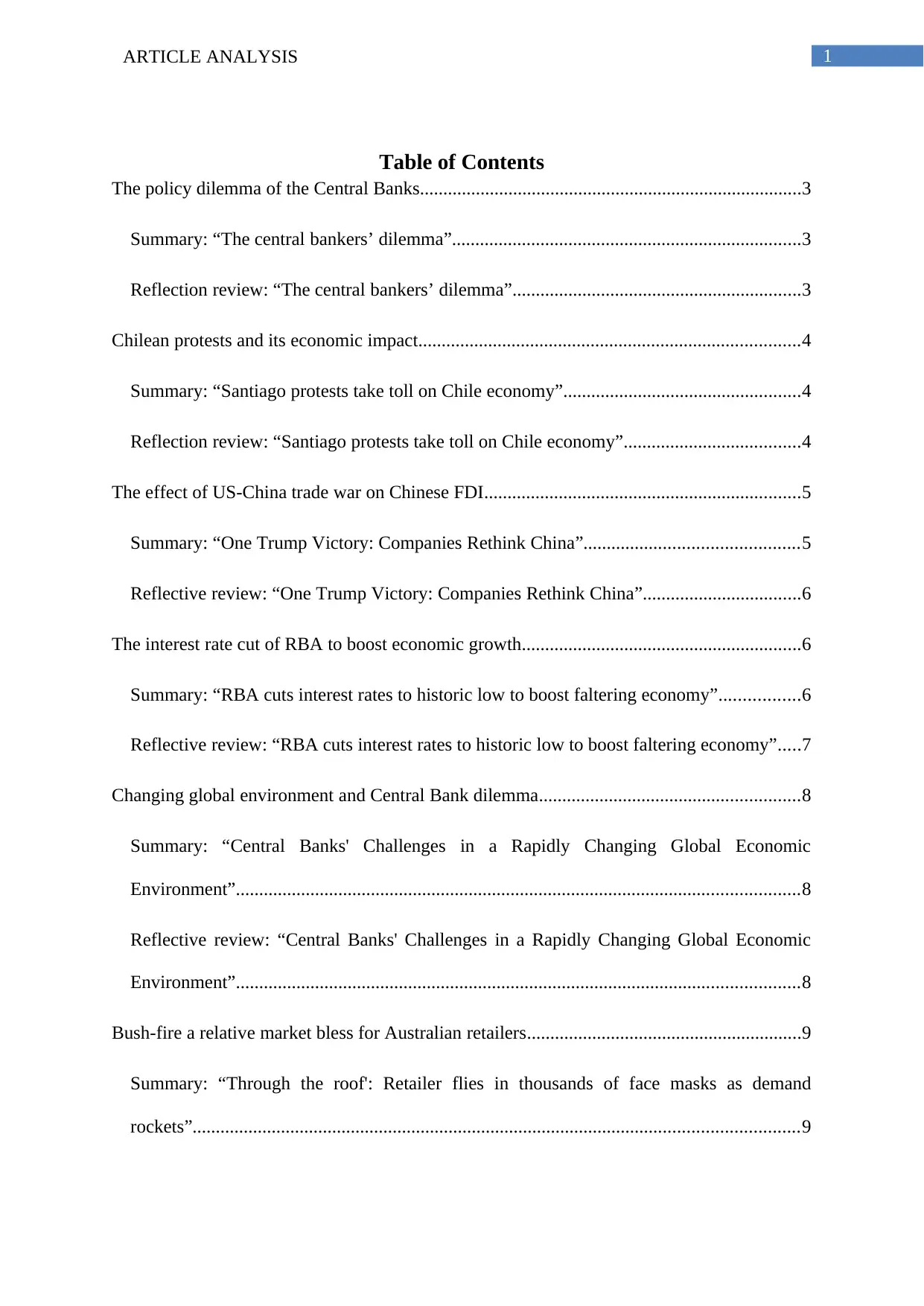
1ARTICLE ANALYSIS
Table of Contents
The policy dilemma of the Central Banks..................................................................................3
Summary: “The central bankers’ dilemma”...........................................................................3
Reflection review: “The central bankers’ dilemma”..............................................................3
Chilean protests and its economic impact..................................................................................4
Summary: “Santiago protests take toll on Chile economy”...................................................4
Reflection review: “Santiago protests take toll on Chile economy”......................................4
The effect of US-China trade war on Chinese FDI....................................................................5
Summary: “One Trump Victory: Companies Rethink China”..............................................5
Reflective review: “One Trump Victory: Companies Rethink China”..................................6
The interest rate cut of RBA to boost economic growth............................................................6
Summary: “RBA cuts interest rates to historic low to boost faltering economy”.................6
Reflective review: “RBA cuts interest rates to historic low to boost faltering economy”.....7
Changing global environment and Central Bank dilemma........................................................8
Summary: “Central Banks' Challenges in a Rapidly Changing Global Economic
Environment”.........................................................................................................................8
Reflective review: “Central Banks' Challenges in a Rapidly Changing Global Economic
Environment”.........................................................................................................................8
Bush-fire a relative market bless for Australian retailers...........................................................9
Summary: “Through the roof': Retailer flies in thousands of face masks as demand
rockets”..................................................................................................................................9
Table of Contents
The policy dilemma of the Central Banks..................................................................................3
Summary: “The central bankers’ dilemma”...........................................................................3
Reflection review: “The central bankers’ dilemma”..............................................................3
Chilean protests and its economic impact..................................................................................4
Summary: “Santiago protests take toll on Chile economy”...................................................4
Reflection review: “Santiago protests take toll on Chile economy”......................................4
The effect of US-China trade war on Chinese FDI....................................................................5
Summary: “One Trump Victory: Companies Rethink China”..............................................5
Reflective review: “One Trump Victory: Companies Rethink China”..................................6
The interest rate cut of RBA to boost economic growth............................................................6
Summary: “RBA cuts interest rates to historic low to boost faltering economy”.................6
Reflective review: “RBA cuts interest rates to historic low to boost faltering economy”.....7
Changing global environment and Central Bank dilemma........................................................8
Summary: “Central Banks' Challenges in a Rapidly Changing Global Economic
Environment”.........................................................................................................................8
Reflective review: “Central Banks' Challenges in a Rapidly Changing Global Economic
Environment”.........................................................................................................................8
Bush-fire a relative market bless for Australian retailers...........................................................9
Summary: “Through the roof': Retailer flies in thousands of face masks as demand
rockets”..................................................................................................................................9
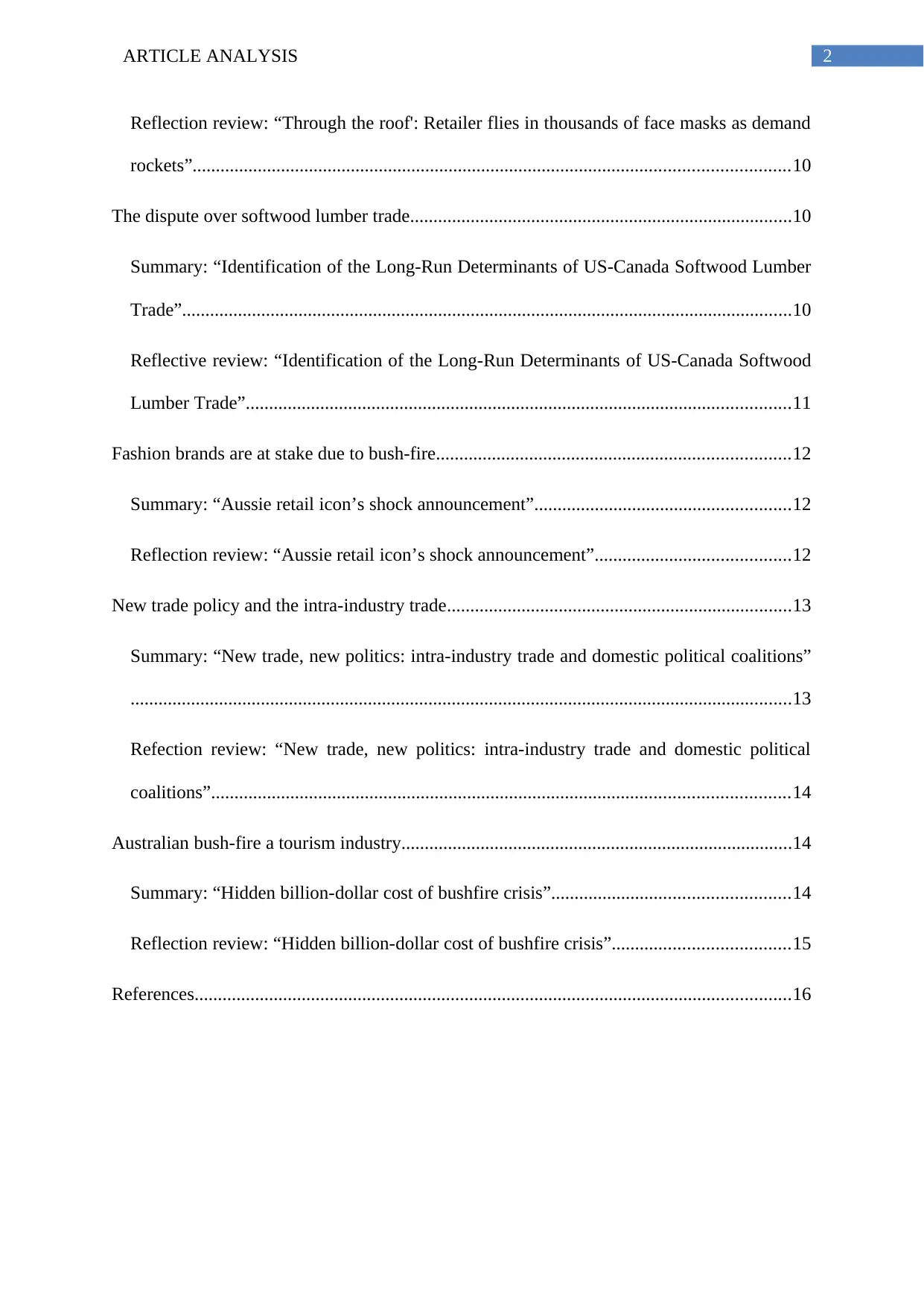
2ARTICLE ANALYSIS
Reflection review: “Through the roof': Retailer flies in thousands of face masks as demand
rockets”................................................................................................................................10
The dispute over softwood lumber trade..................................................................................10
Summary: “Identification of the Long-Run Determinants of US-Canada Softwood Lumber
Trade”...................................................................................................................................10
Reflective review: “Identification of the Long-Run Determinants of US-Canada Softwood
Lumber Trade”.....................................................................................................................11
Fashion brands are at stake due to bush-fire............................................................................12
Summary: “Aussie retail icon’s shock announcement”.......................................................12
Reflection review: “Aussie retail icon’s shock announcement”..........................................12
New trade policy and the intra-industry trade..........................................................................13
Summary: “New trade, new politics: intra-industry trade and domestic political coalitions”
..............................................................................................................................................13
Refection review: “New trade, new politics: intra-industry trade and domestic political
coalitions”............................................................................................................................14
Australian bush-fire a tourism industry....................................................................................14
Summary: “Hidden billion-dollar cost of bushfire crisis”...................................................14
Reflection review: “Hidden billion-dollar cost of bushfire crisis”......................................15
References................................................................................................................................16
Reflection review: “Through the roof': Retailer flies in thousands of face masks as demand
rockets”................................................................................................................................10
The dispute over softwood lumber trade..................................................................................10
Summary: “Identification of the Long-Run Determinants of US-Canada Softwood Lumber
Trade”...................................................................................................................................10
Reflective review: “Identification of the Long-Run Determinants of US-Canada Softwood
Lumber Trade”.....................................................................................................................11
Fashion brands are at stake due to bush-fire............................................................................12
Summary: “Aussie retail icon’s shock announcement”.......................................................12
Reflection review: “Aussie retail icon’s shock announcement”..........................................12
New trade policy and the intra-industry trade..........................................................................13
Summary: “New trade, new politics: intra-industry trade and domestic political coalitions”
..............................................................................................................................................13
Refection review: “New trade, new politics: intra-industry trade and domestic political
coalitions”............................................................................................................................14
Australian bush-fire a tourism industry....................................................................................14
Summary: “Hidden billion-dollar cost of bushfire crisis”...................................................14
Reflection review: “Hidden billion-dollar cost of bushfire crisis”......................................15
References................................................................................................................................16
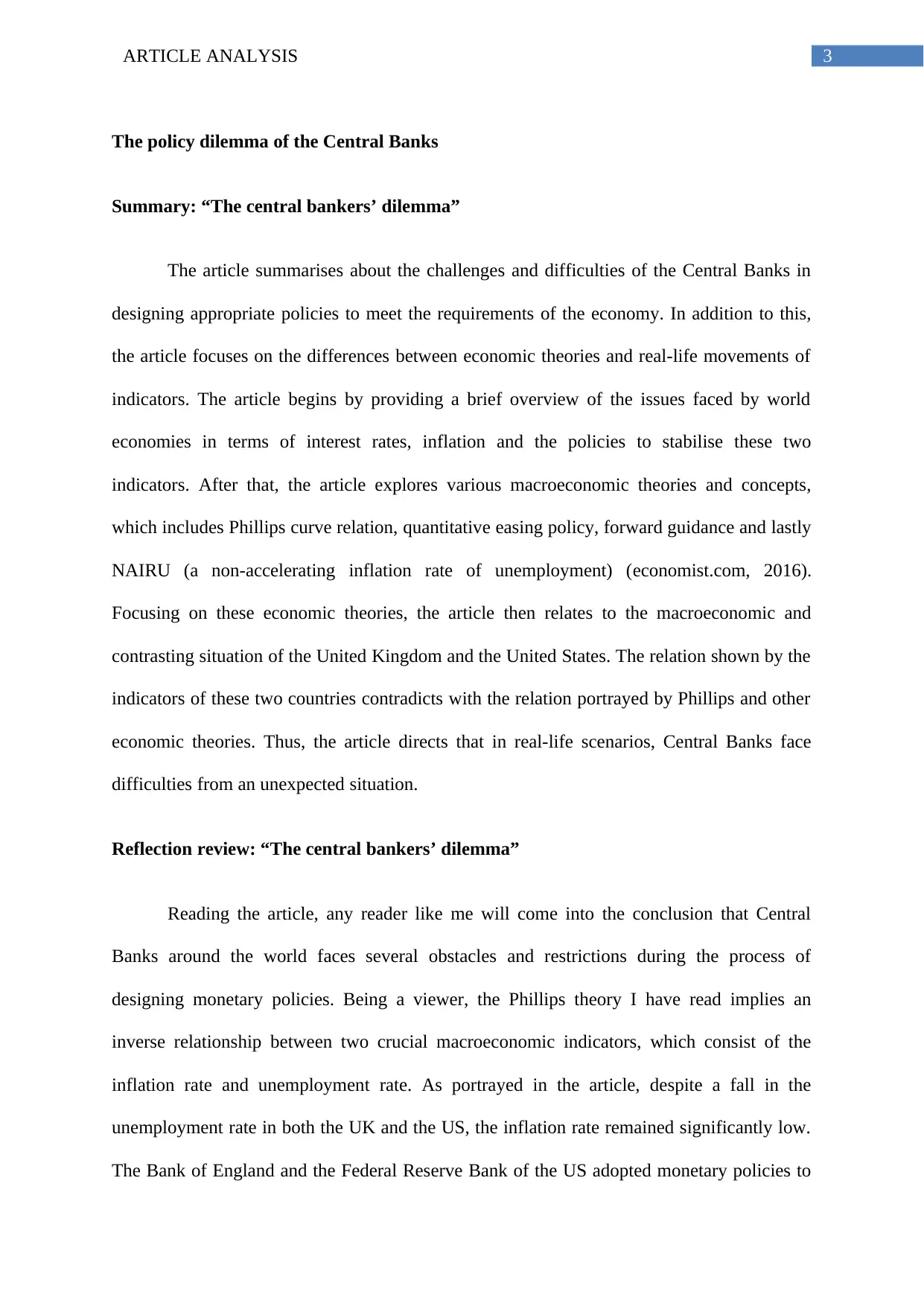
3ARTICLE ANALYSIS
The policy dilemma of the Central Banks
Summary: “The central bankers’ dilemma”
The article summarises about the challenges and difficulties of the Central Banks in
designing appropriate policies to meet the requirements of the economy. In addition to this,
the article focuses on the differences between economic theories and real-life movements of
indicators. The article begins by providing a brief overview of the issues faced by world
economies in terms of interest rates, inflation and the policies to stabilise these two
indicators. After that, the article explores various macroeconomic theories and concepts,
which includes Phillips curve relation, quantitative easing policy, forward guidance and lastly
NAIRU (a non-accelerating inflation rate of unemployment) (economist.com, 2016).
Focusing on these economic theories, the article then relates to the macroeconomic and
contrasting situation of the United Kingdom and the United States. The relation shown by the
indicators of these two countries contradicts with the relation portrayed by Phillips and other
economic theories. Thus, the article directs that in real-life scenarios, Central Banks face
difficulties from an unexpected situation.
Reflection review: “The central bankers’ dilemma”
Reading the article, any reader like me will come into the conclusion that Central
Banks around the world faces several obstacles and restrictions during the process of
designing monetary policies. Being a viewer, the Phillips theory I have read implies an
inverse relationship between two crucial macroeconomic indicators, which consist of the
inflation rate and unemployment rate. As portrayed in the article, despite a fall in the
unemployment rate in both the UK and the US, the inflation rate remained significantly low.
The Bank of England and the Federal Reserve Bank of the US adopted monetary policies to
The policy dilemma of the Central Banks
Summary: “The central bankers’ dilemma”
The article summarises about the challenges and difficulties of the Central Banks in
designing appropriate policies to meet the requirements of the economy. In addition to this,
the article focuses on the differences between economic theories and real-life movements of
indicators. The article begins by providing a brief overview of the issues faced by world
economies in terms of interest rates, inflation and the policies to stabilise these two
indicators. After that, the article explores various macroeconomic theories and concepts,
which includes Phillips curve relation, quantitative easing policy, forward guidance and lastly
NAIRU (a non-accelerating inflation rate of unemployment) (economist.com, 2016).
Focusing on these economic theories, the article then relates to the macroeconomic and
contrasting situation of the United Kingdom and the United States. The relation shown by the
indicators of these two countries contradicts with the relation portrayed by Phillips and other
economic theories. Thus, the article directs that in real-life scenarios, Central Banks face
difficulties from an unexpected situation.
Reflection review: “The central bankers’ dilemma”
Reading the article, any reader like me will come into the conclusion that Central
Banks around the world faces several obstacles and restrictions during the process of
designing monetary policies. Being a viewer, the Phillips theory I have read implies an
inverse relationship between two crucial macroeconomic indicators, which consist of the
inflation rate and unemployment rate. As portrayed in the article, despite a fall in the
unemployment rate in both the UK and the US, the inflation rate remained significantly low.
The Bank of England and the Federal Reserve Bank of the US adopted monetary policies to
Secure Best Marks with AI Grader
Need help grading? Try our AI Grader for instant feedback on your assignments.
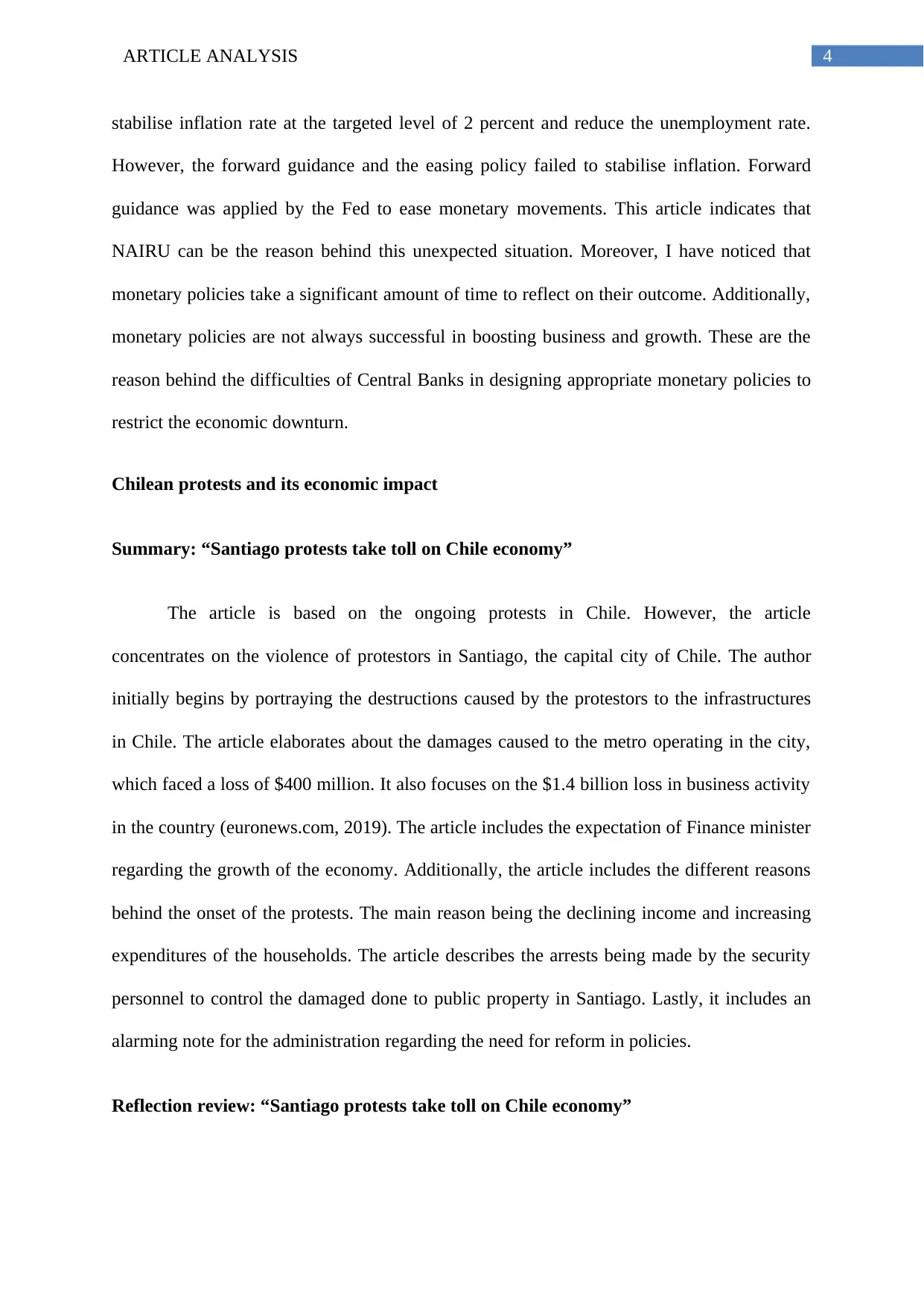
4ARTICLE ANALYSIS
stabilise inflation rate at the targeted level of 2 percent and reduce the unemployment rate.
However, the forward guidance and the easing policy failed to stabilise inflation. Forward
guidance was applied by the Fed to ease monetary movements. This article indicates that
NAIRU can be the reason behind this unexpected situation. Moreover, I have noticed that
monetary policies take a significant amount of time to reflect on their outcome. Additionally,
monetary policies are not always successful in boosting business and growth. These are the
reason behind the difficulties of Central Banks in designing appropriate monetary policies to
restrict the economic downturn.
Chilean protests and its economic impact
Summary: “Santiago protests take toll on Chile economy”
The article is based on the ongoing protests in Chile. However, the article
concentrates on the violence of protestors in Santiago, the capital city of Chile. The author
initially begins by portraying the destructions caused by the protestors to the infrastructures
in Chile. The article elaborates about the damages caused to the metro operating in the city,
which faced a loss of $400 million. It also focuses on the $1.4 billion loss in business activity
in the country (euronews.com, 2019). The article includes the expectation of Finance minister
regarding the growth of the economy. Additionally, the article includes the different reasons
behind the onset of the protests. The main reason being the declining income and increasing
expenditures of the households. The article describes the arrests being made by the security
personnel to control the damaged done to public property in Santiago. Lastly, it includes an
alarming note for the administration regarding the need for reform in policies.
Reflection review: “Santiago protests take toll on Chile economy”
stabilise inflation rate at the targeted level of 2 percent and reduce the unemployment rate.
However, the forward guidance and the easing policy failed to stabilise inflation. Forward
guidance was applied by the Fed to ease monetary movements. This article indicates that
NAIRU can be the reason behind this unexpected situation. Moreover, I have noticed that
monetary policies take a significant amount of time to reflect on their outcome. Additionally,
monetary policies are not always successful in boosting business and growth. These are the
reason behind the difficulties of Central Banks in designing appropriate monetary policies to
restrict the economic downturn.
Chilean protests and its economic impact
Summary: “Santiago protests take toll on Chile economy”
The article is based on the ongoing protests in Chile. However, the article
concentrates on the violence of protestors in Santiago, the capital city of Chile. The author
initially begins by portraying the destructions caused by the protestors to the infrastructures
in Chile. The article elaborates about the damages caused to the metro operating in the city,
which faced a loss of $400 million. It also focuses on the $1.4 billion loss in business activity
in the country (euronews.com, 2019). The article includes the expectation of Finance minister
regarding the growth of the economy. Additionally, the article includes the different reasons
behind the onset of the protests. The main reason being the declining income and increasing
expenditures of the households. The article describes the arrests being made by the security
personnel to control the damaged done to public property in Santiago. Lastly, it includes an
alarming note for the administration regarding the need for reform in policies.
Reflection review: “Santiago protests take toll on Chile economy”
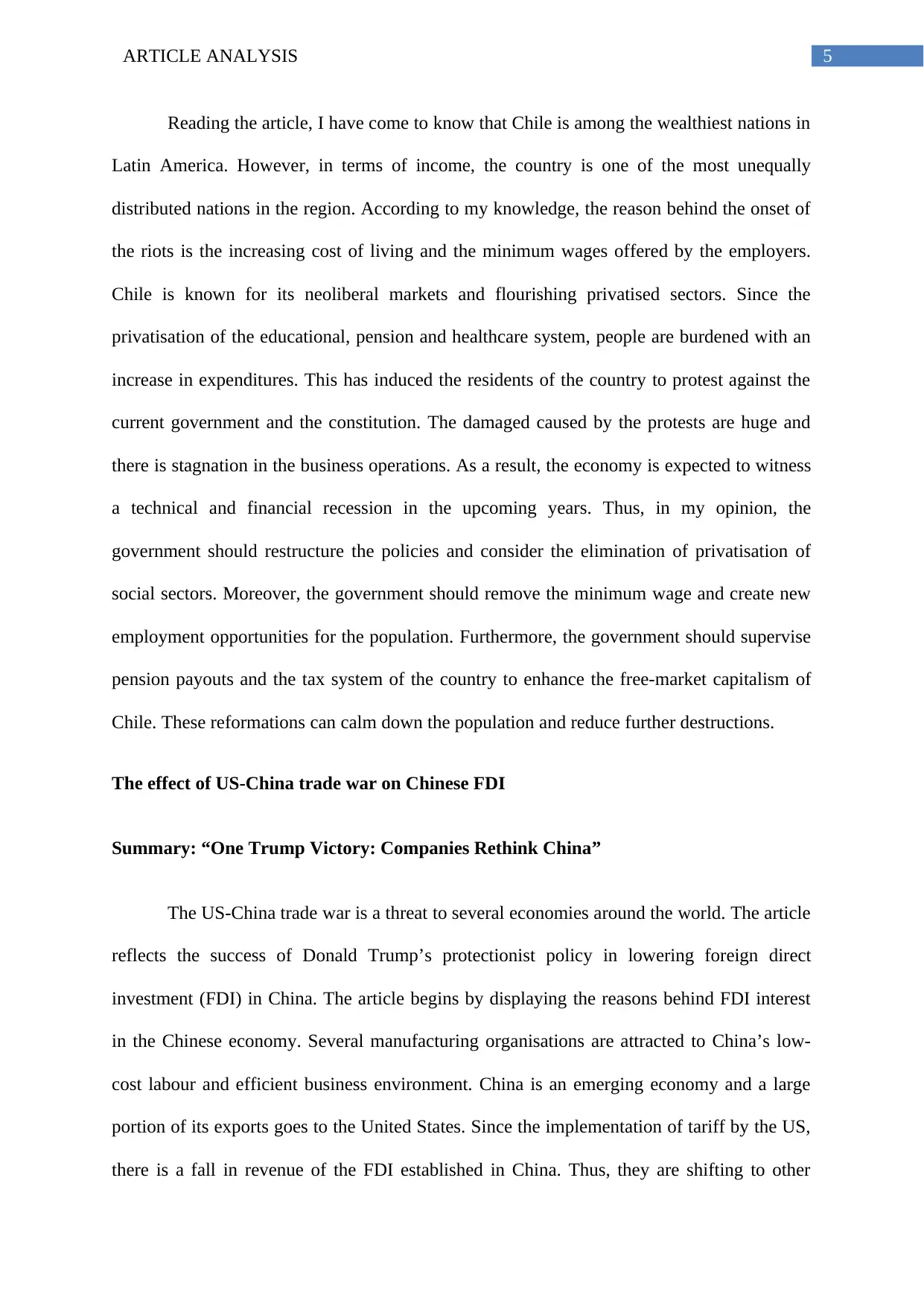
5ARTICLE ANALYSIS
Reading the article, I have come to know that Chile is among the wealthiest nations in
Latin America. However, in terms of income, the country is one of the most unequally
distributed nations in the region. According to my knowledge, the reason behind the onset of
the riots is the increasing cost of living and the minimum wages offered by the employers.
Chile is known for its neoliberal markets and flourishing privatised sectors. Since the
privatisation of the educational, pension and healthcare system, people are burdened with an
increase in expenditures. This has induced the residents of the country to protest against the
current government and the constitution. The damaged caused by the protests are huge and
there is stagnation in the business operations. As a result, the economy is expected to witness
a technical and financial recession in the upcoming years. Thus, in my opinion, the
government should restructure the policies and consider the elimination of privatisation of
social sectors. Moreover, the government should remove the minimum wage and create new
employment opportunities for the population. Furthermore, the government should supervise
pension payouts and the tax system of the country to enhance the free-market capitalism of
Chile. These reformations can calm down the population and reduce further destructions.
The effect of US-China trade war on Chinese FDI
Summary: “One Trump Victory: Companies Rethink China”
The US-China trade war is a threat to several economies around the world. The article
reflects the success of Donald Trump’s protectionist policy in lowering foreign direct
investment (FDI) in China. The article begins by displaying the reasons behind FDI interest
in the Chinese economy. Several manufacturing organisations are attracted to China’s low-
cost labour and efficient business environment. China is an emerging economy and a large
portion of its exports goes to the United States. Since the implementation of tariff by the US,
there is a fall in revenue of the FDI established in China. Thus, they are shifting to other
Reading the article, I have come to know that Chile is among the wealthiest nations in
Latin America. However, in terms of income, the country is one of the most unequally
distributed nations in the region. According to my knowledge, the reason behind the onset of
the riots is the increasing cost of living and the minimum wages offered by the employers.
Chile is known for its neoliberal markets and flourishing privatised sectors. Since the
privatisation of the educational, pension and healthcare system, people are burdened with an
increase in expenditures. This has induced the residents of the country to protest against the
current government and the constitution. The damaged caused by the protests are huge and
there is stagnation in the business operations. As a result, the economy is expected to witness
a technical and financial recession in the upcoming years. Thus, in my opinion, the
government should restructure the policies and consider the elimination of privatisation of
social sectors. Moreover, the government should remove the minimum wage and create new
employment opportunities for the population. Furthermore, the government should supervise
pension payouts and the tax system of the country to enhance the free-market capitalism of
Chile. These reformations can calm down the population and reduce further destructions.
The effect of US-China trade war on Chinese FDI
Summary: “One Trump Victory: Companies Rethink China”
The US-China trade war is a threat to several economies around the world. The article
reflects the success of Donald Trump’s protectionist policy in lowering foreign direct
investment (FDI) in China. The article begins by displaying the reasons behind FDI interest
in the Chinese economy. Several manufacturing organisations are attracted to China’s low-
cost labour and efficient business environment. China is an emerging economy and a large
portion of its exports goes to the United States. Since the implementation of tariff by the US,
there is a fall in revenue of the FDI established in China. Thus, they are shifting to other
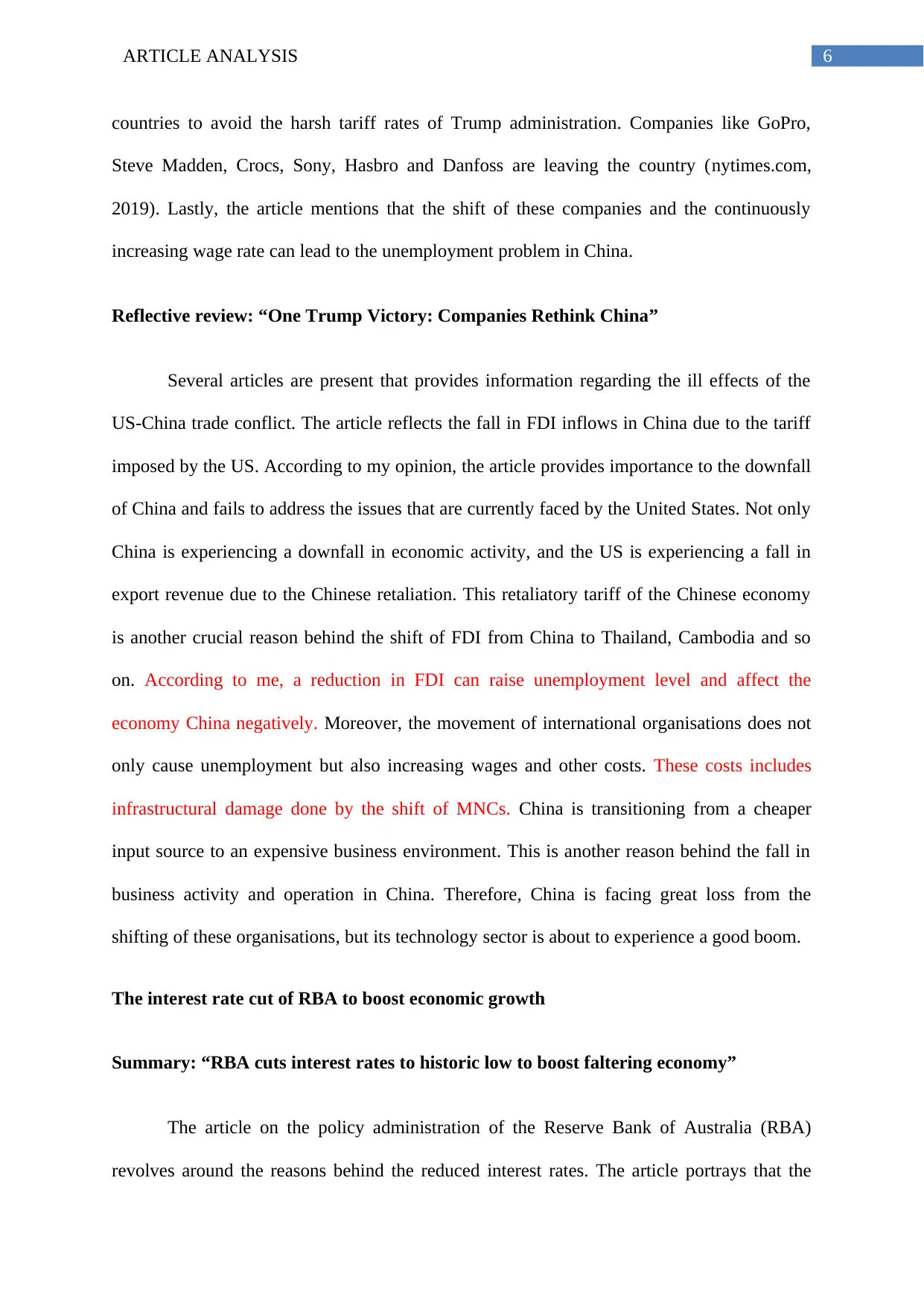
6ARTICLE ANALYSIS
countries to avoid the harsh tariff rates of Trump administration. Companies like GoPro,
Steve Madden, Crocs, Sony, Hasbro and Danfoss are leaving the country (nytimes.com,
2019). Lastly, the article mentions that the shift of these companies and the continuously
increasing wage rate can lead to the unemployment problem in China.
Reflective review: “One Trump Victory: Companies Rethink China”
Several articles are present that provides information regarding the ill effects of the
US-China trade conflict. The article reflects the fall in FDI inflows in China due to the tariff
imposed by the US. According to my opinion, the article provides importance to the downfall
of China and fails to address the issues that are currently faced by the United States. Not only
China is experiencing a downfall in economic activity, and the US is experiencing a fall in
export revenue due to the Chinese retaliation. This retaliatory tariff of the Chinese economy
is another crucial reason behind the shift of FDI from China to Thailand, Cambodia and so
on. According to me, a reduction in FDI can raise unemployment level and affect the
economy China negatively. Moreover, the movement of international organisations does not
only cause unemployment but also increasing wages and other costs. These costs includes
infrastructural damage done by the shift of MNCs. China is transitioning from a cheaper
input source to an expensive business environment. This is another reason behind the fall in
business activity and operation in China. Therefore, China is facing great loss from the
shifting of these organisations, but its technology sector is about to experience a good boom.
The interest rate cut of RBA to boost economic growth
Summary: “RBA cuts interest rates to historic low to boost faltering economy”
The article on the policy administration of the Reserve Bank of Australia (RBA)
revolves around the reasons behind the reduced interest rates. The article portrays that the
countries to avoid the harsh tariff rates of Trump administration. Companies like GoPro,
Steve Madden, Crocs, Sony, Hasbro and Danfoss are leaving the country (nytimes.com,
2019). Lastly, the article mentions that the shift of these companies and the continuously
increasing wage rate can lead to the unemployment problem in China.
Reflective review: “One Trump Victory: Companies Rethink China”
Several articles are present that provides information regarding the ill effects of the
US-China trade conflict. The article reflects the fall in FDI inflows in China due to the tariff
imposed by the US. According to my opinion, the article provides importance to the downfall
of China and fails to address the issues that are currently faced by the United States. Not only
China is experiencing a downfall in economic activity, and the US is experiencing a fall in
export revenue due to the Chinese retaliation. This retaliatory tariff of the Chinese economy
is another crucial reason behind the shift of FDI from China to Thailand, Cambodia and so
on. According to me, a reduction in FDI can raise unemployment level and affect the
economy China negatively. Moreover, the movement of international organisations does not
only cause unemployment but also increasing wages and other costs. These costs includes
infrastructural damage done by the shift of MNCs. China is transitioning from a cheaper
input source to an expensive business environment. This is another reason behind the fall in
business activity and operation in China. Therefore, China is facing great loss from the
shifting of these organisations, but its technology sector is about to experience a good boom.
The interest rate cut of RBA to boost economic growth
Summary: “RBA cuts interest rates to historic low to boost faltering economy”
The article on the policy administration of the Reserve Bank of Australia (RBA)
revolves around the reasons behind the reduced interest rates. The article portrays that the
Paraphrase This Document
Need a fresh take? Get an instant paraphrase of this document with our AI Paraphraser
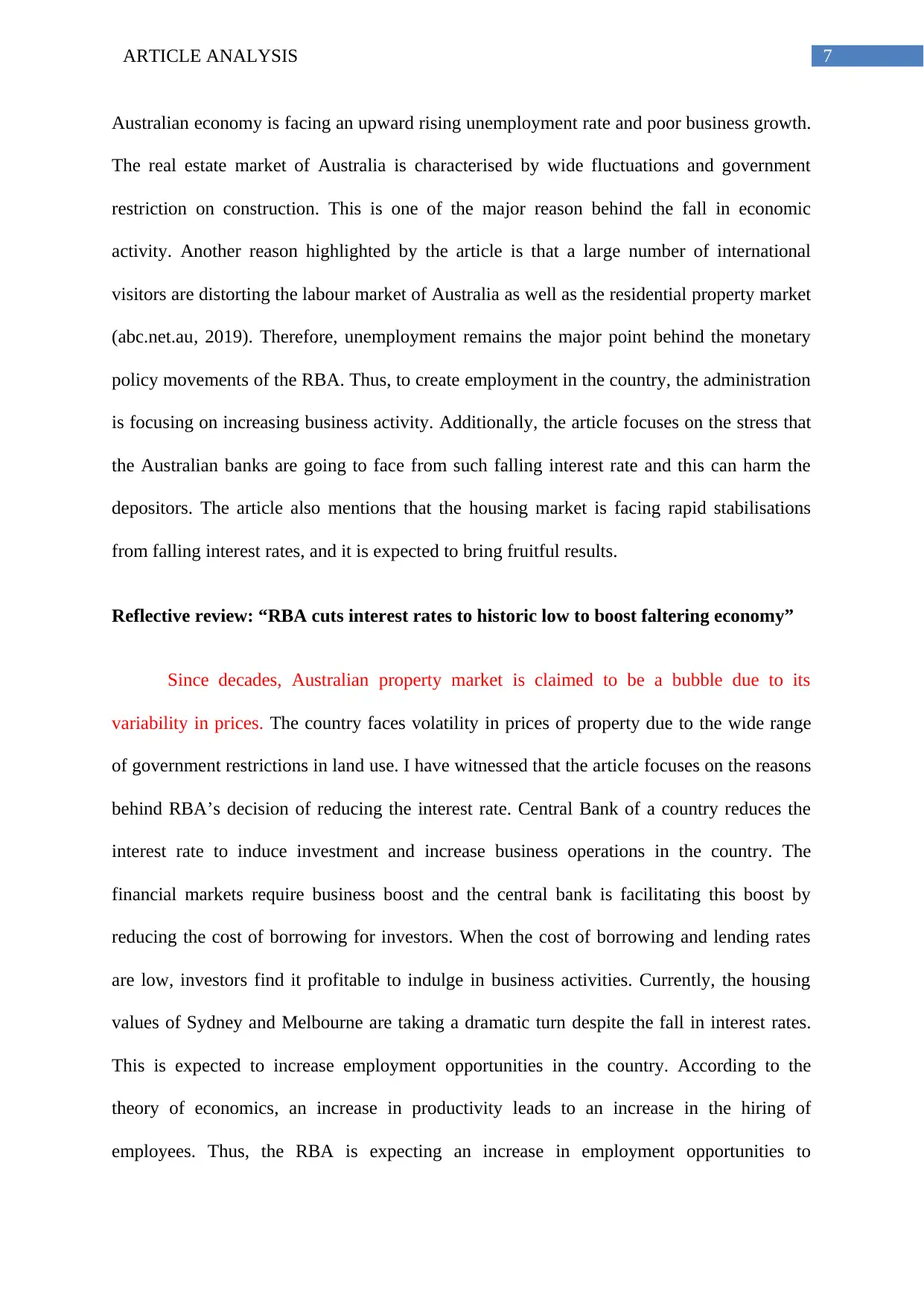
7ARTICLE ANALYSIS
Australian economy is facing an upward rising unemployment rate and poor business growth.
The real estate market of Australia is characterised by wide fluctuations and government
restriction on construction. This is one of the major reason behind the fall in economic
activity. Another reason highlighted by the article is that a large number of international
visitors are distorting the labour market of Australia as well as the residential property market
(abc.net.au, 2019). Therefore, unemployment remains the major point behind the monetary
policy movements of the RBA. Thus, to create employment in the country, the administration
is focusing on increasing business activity. Additionally, the article focuses on the stress that
the Australian banks are going to face from such falling interest rate and this can harm the
depositors. The article also mentions that the housing market is facing rapid stabilisations
from falling interest rates, and it is expected to bring fruitful results.
Reflective review: “RBA cuts interest rates to historic low to boost faltering economy”
Since decades, Australian property market is claimed to be a bubble due to its
variability in prices. The country faces volatility in prices of property due to the wide range
of government restrictions in land use. I have witnessed that the article focuses on the reasons
behind RBA’s decision of reducing the interest rate. Central Bank of a country reduces the
interest rate to induce investment and increase business operations in the country. The
financial markets require business boost and the central bank is facilitating this boost by
reducing the cost of borrowing for investors. When the cost of borrowing and lending rates
are low, investors find it profitable to indulge in business activities. Currently, the housing
values of Sydney and Melbourne are taking a dramatic turn despite the fall in interest rates.
This is expected to increase employment opportunities in the country. According to the
theory of economics, an increase in productivity leads to an increase in the hiring of
employees. Thus, the RBA is expecting an increase in employment opportunities to
Australian economy is facing an upward rising unemployment rate and poor business growth.
The real estate market of Australia is characterised by wide fluctuations and government
restriction on construction. This is one of the major reason behind the fall in economic
activity. Another reason highlighted by the article is that a large number of international
visitors are distorting the labour market of Australia as well as the residential property market
(abc.net.au, 2019). Therefore, unemployment remains the major point behind the monetary
policy movements of the RBA. Thus, to create employment in the country, the administration
is focusing on increasing business activity. Additionally, the article focuses on the stress that
the Australian banks are going to face from such falling interest rate and this can harm the
depositors. The article also mentions that the housing market is facing rapid stabilisations
from falling interest rates, and it is expected to bring fruitful results.
Reflective review: “RBA cuts interest rates to historic low to boost faltering economy”
Since decades, Australian property market is claimed to be a bubble due to its
variability in prices. The country faces volatility in prices of property due to the wide range
of government restrictions in land use. I have witnessed that the article focuses on the reasons
behind RBA’s decision of reducing the interest rate. Central Bank of a country reduces the
interest rate to induce investment and increase business operations in the country. The
financial markets require business boost and the central bank is facilitating this boost by
reducing the cost of borrowing for investors. When the cost of borrowing and lending rates
are low, investors find it profitable to indulge in business activities. Currently, the housing
values of Sydney and Melbourne are taking a dramatic turn despite the fall in interest rates.
This is expected to increase employment opportunities in the country. According to the
theory of economics, an increase in productivity leads to an increase in the hiring of
employees. Thus, the RBA is expecting an increase in employment opportunities to
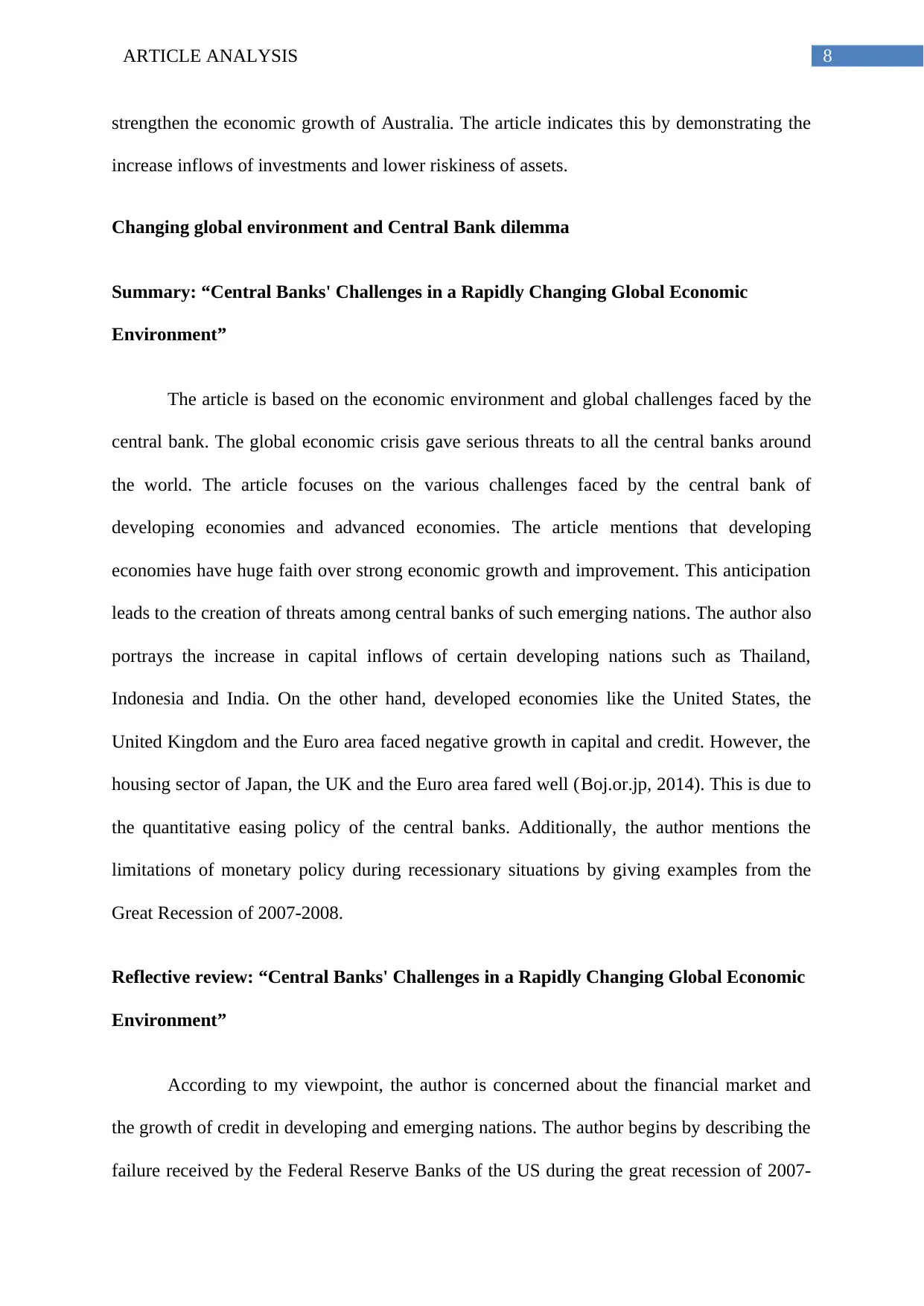
8ARTICLE ANALYSIS
strengthen the economic growth of Australia. The article indicates this by demonstrating the
increase inflows of investments and lower riskiness of assets.
Changing global environment and Central Bank dilemma
Summary: “Central Banks' Challenges in a Rapidly Changing Global Economic
Environment”
The article is based on the economic environment and global challenges faced by the
central bank. The global economic crisis gave serious threats to all the central banks around
the world. The article focuses on the various challenges faced by the central bank of
developing economies and advanced economies. The article mentions that developing
economies have huge faith over strong economic growth and improvement. This anticipation
leads to the creation of threats among central banks of such emerging nations. The author also
portrays the increase in capital inflows of certain developing nations such as Thailand,
Indonesia and India. On the other hand, developed economies like the United States, the
United Kingdom and the Euro area faced negative growth in capital and credit. However, the
housing sector of Japan, the UK and the Euro area fared well (Boj.or.jp, 2014). This is due to
the quantitative easing policy of the central banks. Additionally, the author mentions the
limitations of monetary policy during recessionary situations by giving examples from the
Great Recession of 2007-2008.
Reflective review: “Central Banks' Challenges in a Rapidly Changing Global Economic
Environment”
According to my viewpoint, the author is concerned about the financial market and
the growth of credit in developing and emerging nations. The author begins by describing the
failure received by the Federal Reserve Banks of the US during the great recession of 2007-
strengthen the economic growth of Australia. The article indicates this by demonstrating the
increase inflows of investments and lower riskiness of assets.
Changing global environment and Central Bank dilemma
Summary: “Central Banks' Challenges in a Rapidly Changing Global Economic
Environment”
The article is based on the economic environment and global challenges faced by the
central bank. The global economic crisis gave serious threats to all the central banks around
the world. The article focuses on the various challenges faced by the central bank of
developing economies and advanced economies. The article mentions that developing
economies have huge faith over strong economic growth and improvement. This anticipation
leads to the creation of threats among central banks of such emerging nations. The author also
portrays the increase in capital inflows of certain developing nations such as Thailand,
Indonesia and India. On the other hand, developed economies like the United States, the
United Kingdom and the Euro area faced negative growth in capital and credit. However, the
housing sector of Japan, the UK and the Euro area fared well (Boj.or.jp, 2014). This is due to
the quantitative easing policy of the central banks. Additionally, the author mentions the
limitations of monetary policy during recessionary situations by giving examples from the
Great Recession of 2007-2008.
Reflective review: “Central Banks' Challenges in a Rapidly Changing Global Economic
Environment”
According to my viewpoint, the author is concerned about the financial market and
the growth of credit in developing and emerging nations. The author begins by describing the
failure received by the Federal Reserve Banks of the US during the great recession of 2007-
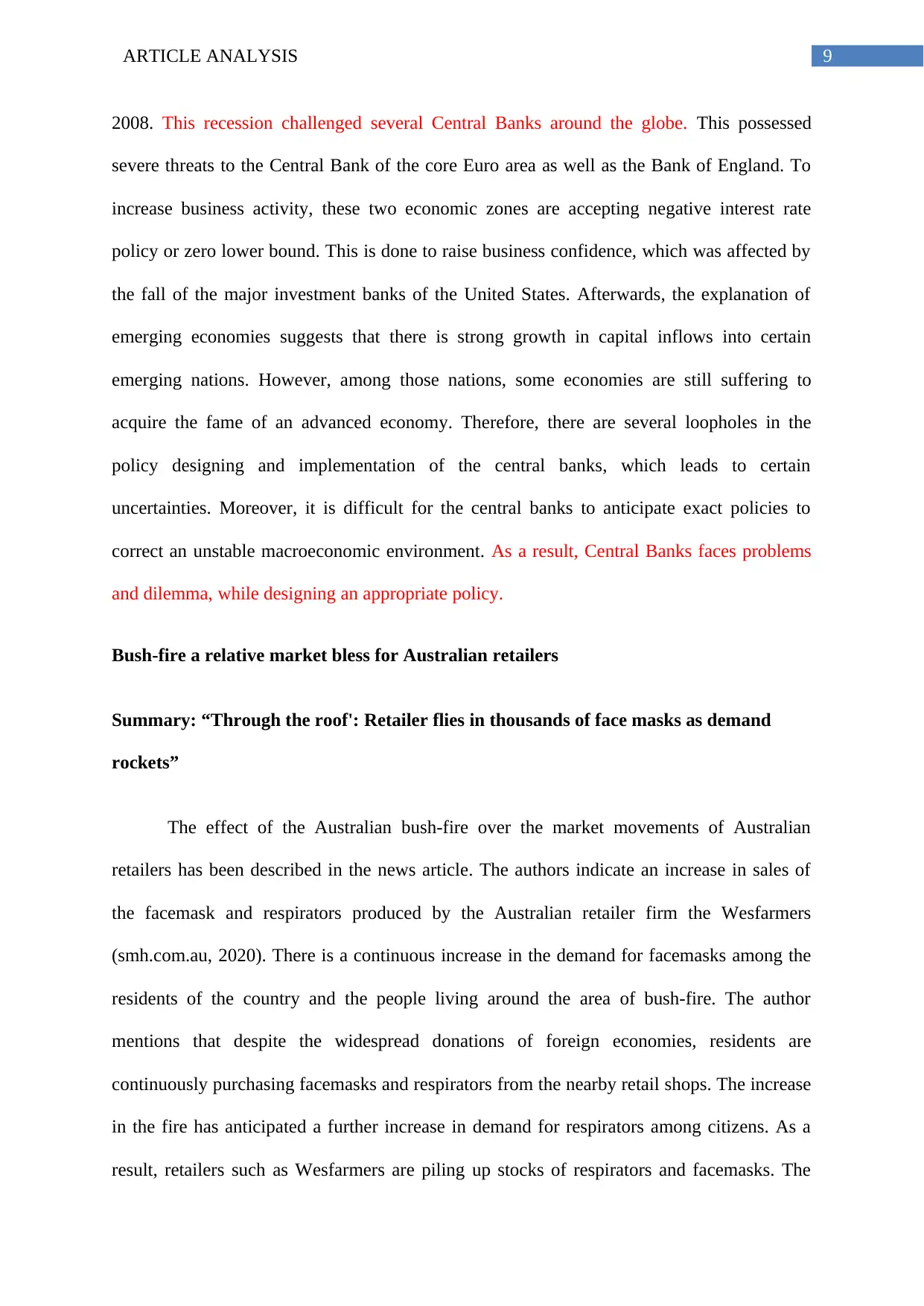
9ARTICLE ANALYSIS
2008. This recession challenged several Central Banks around the globe. This possessed
severe threats to the Central Bank of the core Euro area as well as the Bank of England. To
increase business activity, these two economic zones are accepting negative interest rate
policy or zero lower bound. This is done to raise business confidence, which was affected by
the fall of the major investment banks of the United States. Afterwards, the explanation of
emerging economies suggests that there is strong growth in capital inflows into certain
emerging nations. However, among those nations, some economies are still suffering to
acquire the fame of an advanced economy. Therefore, there are several loopholes in the
policy designing and implementation of the central banks, which leads to certain
uncertainties. Moreover, it is difficult for the central banks to anticipate exact policies to
correct an unstable macroeconomic environment. As a result, Central Banks faces problems
and dilemma, while designing an appropriate policy.
Bush-fire a relative market bless for Australian retailers
Summary: “Through the roof': Retailer flies in thousands of face masks as demand
rockets”
The effect of the Australian bush-fire over the market movements of Australian
retailers has been described in the news article. The authors indicate an increase in sales of
the facemask and respirators produced by the Australian retailer firm the Wesfarmers
(smh.com.au, 2020). There is a continuous increase in the demand for facemasks among the
residents of the country and the people living around the area of bush-fire. The author
mentions that despite the widespread donations of foreign economies, residents are
continuously purchasing facemasks and respirators from the nearby retail shops. The increase
in the fire has anticipated a further increase in demand for respirators among citizens. As a
result, retailers such as Wesfarmers are piling up stocks of respirators and facemasks. The
2008. This recession challenged several Central Banks around the globe. This possessed
severe threats to the Central Bank of the core Euro area as well as the Bank of England. To
increase business activity, these two economic zones are accepting negative interest rate
policy or zero lower bound. This is done to raise business confidence, which was affected by
the fall of the major investment banks of the United States. Afterwards, the explanation of
emerging economies suggests that there is strong growth in capital inflows into certain
emerging nations. However, among those nations, some economies are still suffering to
acquire the fame of an advanced economy. Therefore, there are several loopholes in the
policy designing and implementation of the central banks, which leads to certain
uncertainties. Moreover, it is difficult for the central banks to anticipate exact policies to
correct an unstable macroeconomic environment. As a result, Central Banks faces problems
and dilemma, while designing an appropriate policy.
Bush-fire a relative market bless for Australian retailers
Summary: “Through the roof': Retailer flies in thousands of face masks as demand
rockets”
The effect of the Australian bush-fire over the market movements of Australian
retailers has been described in the news article. The authors indicate an increase in sales of
the facemask and respirators produced by the Australian retailer firm the Wesfarmers
(smh.com.au, 2020). There is a continuous increase in the demand for facemasks among the
residents of the country and the people living around the area of bush-fire. The author
mentions that despite the widespread donations of foreign economies, residents are
continuously purchasing facemasks and respirators from the nearby retail shops. The increase
in the fire has anticipated a further increase in demand for respirators among citizens. As a
result, retailers such as Wesfarmers are piling up stocks of respirators and facemasks. The
Secure Best Marks with AI Grader
Need help grading? Try our AI Grader for instant feedback on your assignments.
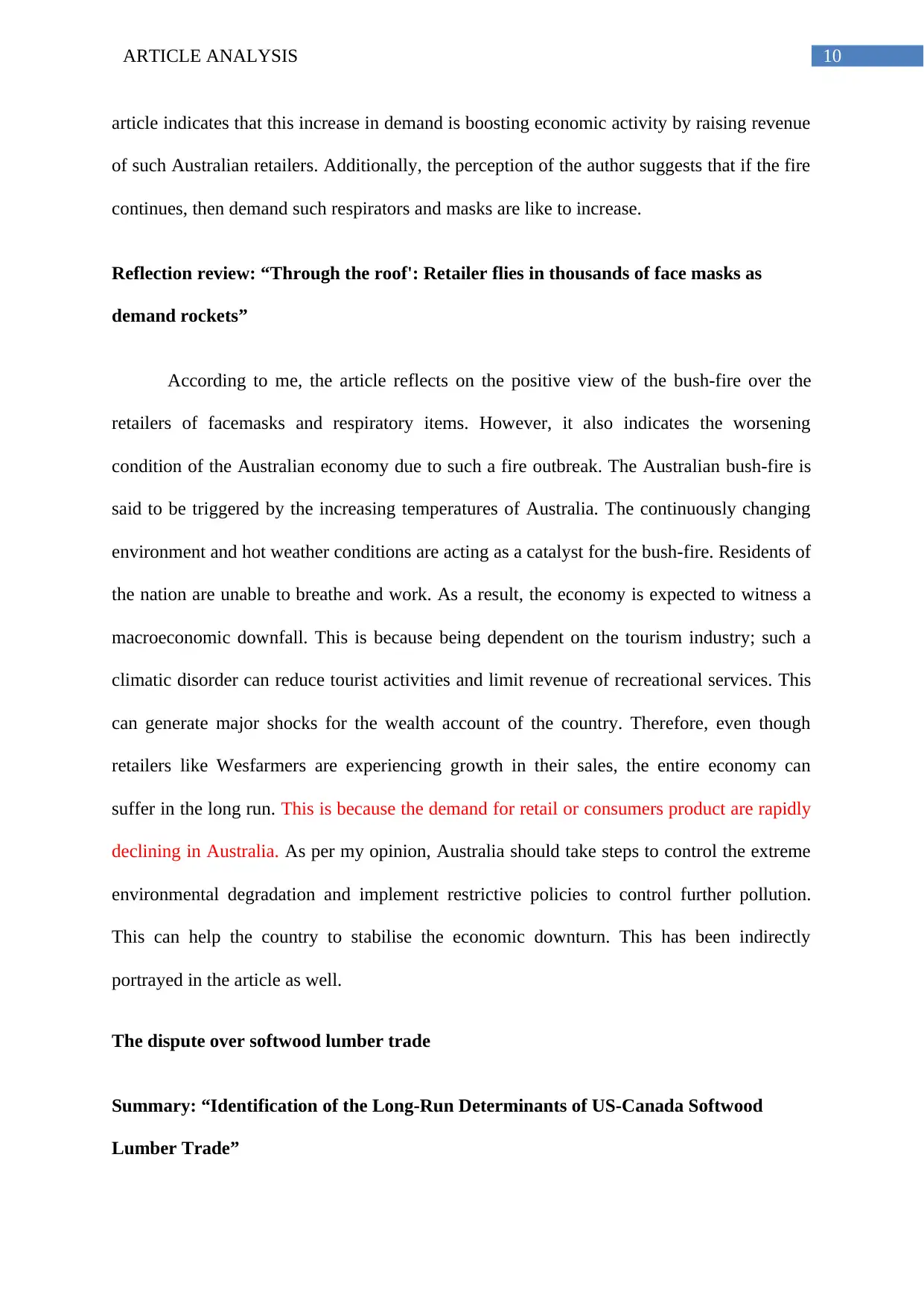
10ARTICLE ANALYSIS
article indicates that this increase in demand is boosting economic activity by raising revenue
of such Australian retailers. Additionally, the perception of the author suggests that if the fire
continues, then demand such respirators and masks are like to increase.
Reflection review: “Through the roof': Retailer flies in thousands of face masks as
demand rockets”
According to me, the article reflects on the positive view of the bush-fire over the
retailers of facemasks and respiratory items. However, it also indicates the worsening
condition of the Australian economy due to such a fire outbreak. The Australian bush-fire is
said to be triggered by the increasing temperatures of Australia. The continuously changing
environment and hot weather conditions are acting as a catalyst for the bush-fire. Residents of
the nation are unable to breathe and work. As a result, the economy is expected to witness a
macroeconomic downfall. This is because being dependent on the tourism industry; such a
climatic disorder can reduce tourist activities and limit revenue of recreational services. This
can generate major shocks for the wealth account of the country. Therefore, even though
retailers like Wesfarmers are experiencing growth in their sales, the entire economy can
suffer in the long run. This is because the demand for retail or consumers product are rapidly
declining in Australia. As per my opinion, Australia should take steps to control the extreme
environmental degradation and implement restrictive policies to control further pollution.
This can help the country to stabilise the economic downturn. This has been indirectly
portrayed in the article as well.
The dispute over softwood lumber trade
Summary: “Identification of the Long-Run Determinants of US-Canada Softwood
Lumber Trade”
article indicates that this increase in demand is boosting economic activity by raising revenue
of such Australian retailers. Additionally, the perception of the author suggests that if the fire
continues, then demand such respirators and masks are like to increase.
Reflection review: “Through the roof': Retailer flies in thousands of face masks as
demand rockets”
According to me, the article reflects on the positive view of the bush-fire over the
retailers of facemasks and respiratory items. However, it also indicates the worsening
condition of the Australian economy due to such a fire outbreak. The Australian bush-fire is
said to be triggered by the increasing temperatures of Australia. The continuously changing
environment and hot weather conditions are acting as a catalyst for the bush-fire. Residents of
the nation are unable to breathe and work. As a result, the economy is expected to witness a
macroeconomic downfall. This is because being dependent on the tourism industry; such a
climatic disorder can reduce tourist activities and limit revenue of recreational services. This
can generate major shocks for the wealth account of the country. Therefore, even though
retailers like Wesfarmers are experiencing growth in their sales, the entire economy can
suffer in the long run. This is because the demand for retail or consumers product are rapidly
declining in Australia. As per my opinion, Australia should take steps to control the extreme
environmental degradation and implement restrictive policies to control further pollution.
This can help the country to stabilise the economic downturn. This has been indirectly
portrayed in the article as well.
The dispute over softwood lumber trade
Summary: “Identification of the Long-Run Determinants of US-Canada Softwood
Lumber Trade”
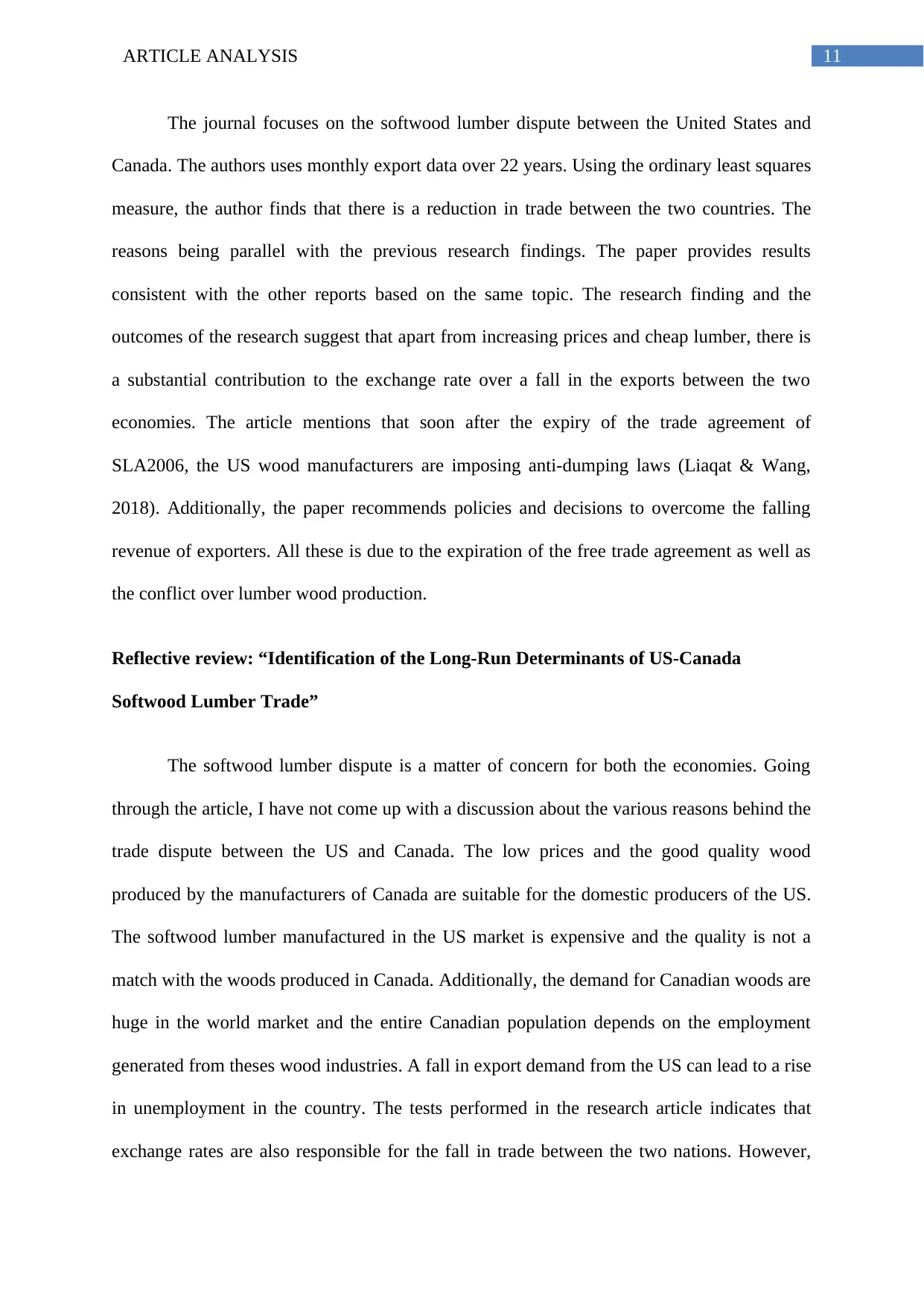
11ARTICLE ANALYSIS
The journal focuses on the softwood lumber dispute between the United States and
Canada. The authors uses monthly export data over 22 years. Using the ordinary least squares
measure, the author finds that there is a reduction in trade between the two countries. The
reasons being parallel with the previous research findings. The paper provides results
consistent with the other reports based on the same topic. The research finding and the
outcomes of the research suggest that apart from increasing prices and cheap lumber, there is
a substantial contribution to the exchange rate over a fall in the exports between the two
economies. The article mentions that soon after the expiry of the trade agreement of
SLA2006, the US wood manufacturers are imposing anti-dumping laws (Liaqat & Wang,
2018). Additionally, the paper recommends policies and decisions to overcome the falling
revenue of exporters. All these is due to the expiration of the free trade agreement as well as
the conflict over lumber wood production.
Reflective review: “Identification of the Long-Run Determinants of US-Canada
Softwood Lumber Trade”
The softwood lumber dispute is a matter of concern for both the economies. Going
through the article, I have not come up with a discussion about the various reasons behind the
trade dispute between the US and Canada. The low prices and the good quality wood
produced by the manufacturers of Canada are suitable for the domestic producers of the US.
The softwood lumber manufactured in the US market is expensive and the quality is not a
match with the woods produced in Canada. Additionally, the demand for Canadian woods are
huge in the world market and the entire Canadian population depends on the employment
generated from theses wood industries. A fall in export demand from the US can lead to a rise
in unemployment in the country. The tests performed in the research article indicates that
exchange rates are also responsible for the fall in trade between the two nations. However,
The journal focuses on the softwood lumber dispute between the United States and
Canada. The authors uses monthly export data over 22 years. Using the ordinary least squares
measure, the author finds that there is a reduction in trade between the two countries. The
reasons being parallel with the previous research findings. The paper provides results
consistent with the other reports based on the same topic. The research finding and the
outcomes of the research suggest that apart from increasing prices and cheap lumber, there is
a substantial contribution to the exchange rate over a fall in the exports between the two
economies. The article mentions that soon after the expiry of the trade agreement of
SLA2006, the US wood manufacturers are imposing anti-dumping laws (Liaqat & Wang,
2018). Additionally, the paper recommends policies and decisions to overcome the falling
revenue of exporters. All these is due to the expiration of the free trade agreement as well as
the conflict over lumber wood production.
Reflective review: “Identification of the Long-Run Determinants of US-Canada
Softwood Lumber Trade”
The softwood lumber dispute is a matter of concern for both the economies. Going
through the article, I have not come up with a discussion about the various reasons behind the
trade dispute between the US and Canada. The low prices and the good quality wood
produced by the manufacturers of Canada are suitable for the domestic producers of the US.
The softwood lumber manufactured in the US market is expensive and the quality is not a
match with the woods produced in Canada. Additionally, the demand for Canadian woods are
huge in the world market and the entire Canadian population depends on the employment
generated from theses wood industries. A fall in export demand from the US can lead to a rise
in unemployment in the country. The tests performed in the research article indicates that
exchange rates are also responsible for the fall in trade between the two nations. However,
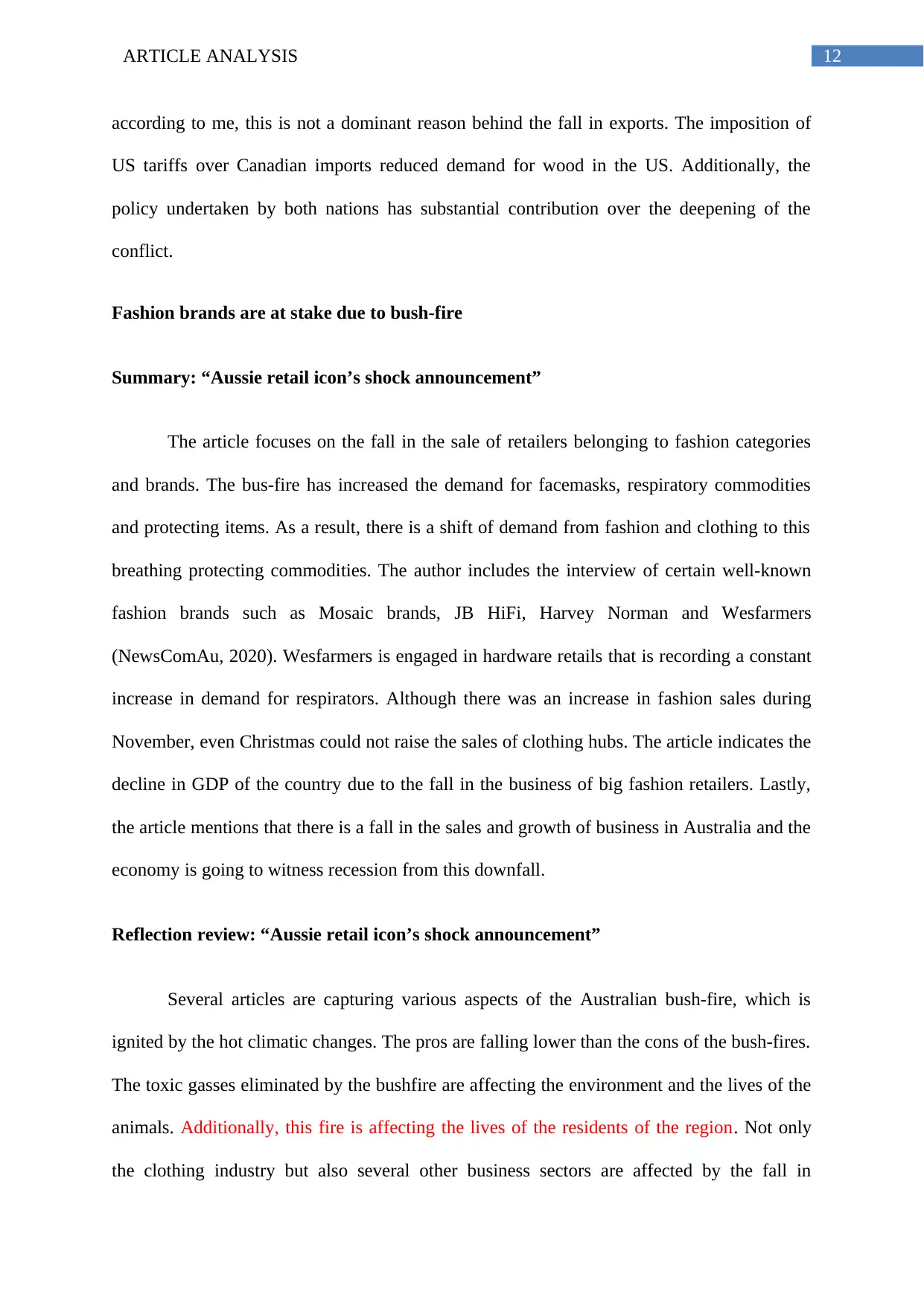
12ARTICLE ANALYSIS
according to me, this is not a dominant reason behind the fall in exports. The imposition of
US tariffs over Canadian imports reduced demand for wood in the US. Additionally, the
policy undertaken by both nations has substantial contribution over the deepening of the
conflict.
Fashion brands are at stake due to bush-fire
Summary: “Aussie retail icon’s shock announcement”
The article focuses on the fall in the sale of retailers belonging to fashion categories
and brands. The bus-fire has increased the demand for facemasks, respiratory commodities
and protecting items. As a result, there is a shift of demand from fashion and clothing to this
breathing protecting commodities. The author includes the interview of certain well-known
fashion brands such as Mosaic brands, JB HiFi, Harvey Norman and Wesfarmers
(NewsComAu, 2020). Wesfarmers is engaged in hardware retails that is recording a constant
increase in demand for respirators. Although there was an increase in fashion sales during
November, even Christmas could not raise the sales of clothing hubs. The article indicates the
decline in GDP of the country due to the fall in the business of big fashion retailers. Lastly,
the article mentions that there is a fall in the sales and growth of business in Australia and the
economy is going to witness recession from this downfall.
Reflection review: “Aussie retail icon’s shock announcement”
Several articles are capturing various aspects of the Australian bush-fire, which is
ignited by the hot climatic changes. The pros are falling lower than the cons of the bush-fires.
The toxic gasses eliminated by the bushfire are affecting the environment and the lives of the
animals. Additionally, this fire is affecting the lives of the residents of the region. Not only
the clothing industry but also several other business sectors are affected by the fall in
according to me, this is not a dominant reason behind the fall in exports. The imposition of
US tariffs over Canadian imports reduced demand for wood in the US. Additionally, the
policy undertaken by both nations has substantial contribution over the deepening of the
conflict.
Fashion brands are at stake due to bush-fire
Summary: “Aussie retail icon’s shock announcement”
The article focuses on the fall in the sale of retailers belonging to fashion categories
and brands. The bus-fire has increased the demand for facemasks, respiratory commodities
and protecting items. As a result, there is a shift of demand from fashion and clothing to this
breathing protecting commodities. The author includes the interview of certain well-known
fashion brands such as Mosaic brands, JB HiFi, Harvey Norman and Wesfarmers
(NewsComAu, 2020). Wesfarmers is engaged in hardware retails that is recording a constant
increase in demand for respirators. Although there was an increase in fashion sales during
November, even Christmas could not raise the sales of clothing hubs. The article indicates the
decline in GDP of the country due to the fall in the business of big fashion retailers. Lastly,
the article mentions that there is a fall in the sales and growth of business in Australia and the
economy is going to witness recession from this downfall.
Reflection review: “Aussie retail icon’s shock announcement”
Several articles are capturing various aspects of the Australian bush-fire, which is
ignited by the hot climatic changes. The pros are falling lower than the cons of the bush-fires.
The toxic gasses eliminated by the bushfire are affecting the environment and the lives of the
animals. Additionally, this fire is affecting the lives of the residents of the region. Not only
the clothing industry but also several other business sectors are affected by the fall in
Paraphrase This Document
Need a fresh take? Get an instant paraphrase of this document with our AI Paraphraser
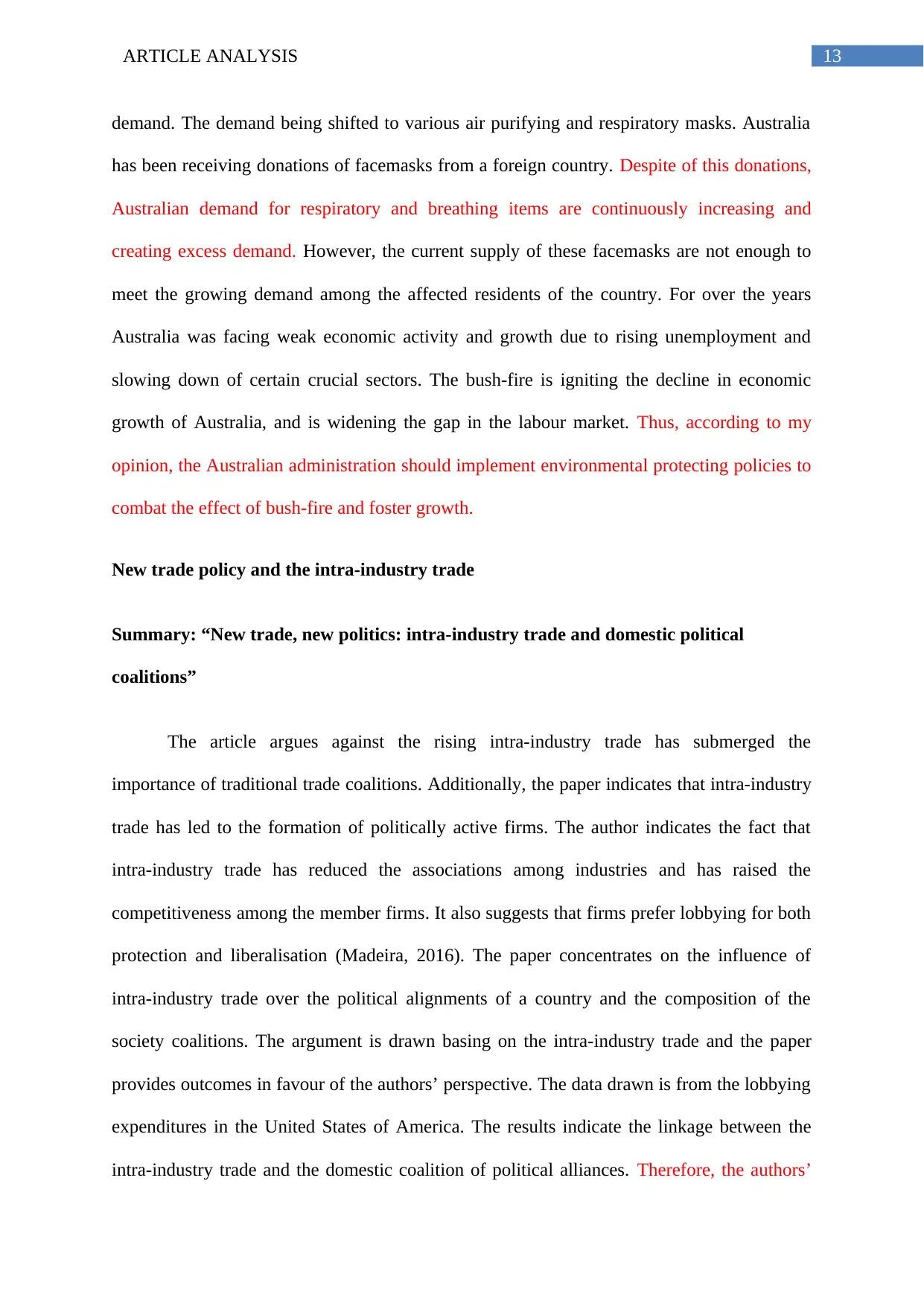
13ARTICLE ANALYSIS
demand. The demand being shifted to various air purifying and respiratory masks. Australia
has been receiving donations of facemasks from a foreign country. Despite of this donations,
Australian demand for respiratory and breathing items are continuously increasing and
creating excess demand. However, the current supply of these facemasks are not enough to
meet the growing demand among the affected residents of the country. For over the years
Australia was facing weak economic activity and growth due to rising unemployment and
slowing down of certain crucial sectors. The bush-fire is igniting the decline in economic
growth of Australia, and is widening the gap in the labour market. Thus, according to my
opinion, the Australian administration should implement environmental protecting policies to
combat the effect of bush-fire and foster growth.
New trade policy and the intra-industry trade
Summary: “New trade, new politics: intra-industry trade and domestic political
coalitions”
The article argues against the rising intra-industry trade has submerged the
importance of traditional trade coalitions. Additionally, the paper indicates that intra-industry
trade has led to the formation of politically active firms. The author indicates the fact that
intra-industry trade has reduced the associations among industries and has raised the
competitiveness among the member firms. It also suggests that firms prefer lobbying for both
protection and liberalisation (Madeira, 2016). The paper concentrates on the influence of
intra-industry trade over the political alignments of a country and the composition of the
society coalitions. The argument is drawn basing on the intra-industry trade and the paper
provides outcomes in favour of the authors’ perspective. The data drawn is from the lobbying
expenditures in the United States of America. The results indicate the linkage between the
intra-industry trade and the domestic coalition of political alliances. Therefore, the authors’
demand. The demand being shifted to various air purifying and respiratory masks. Australia
has been receiving donations of facemasks from a foreign country. Despite of this donations,
Australian demand for respiratory and breathing items are continuously increasing and
creating excess demand. However, the current supply of these facemasks are not enough to
meet the growing demand among the affected residents of the country. For over the years
Australia was facing weak economic activity and growth due to rising unemployment and
slowing down of certain crucial sectors. The bush-fire is igniting the decline in economic
growth of Australia, and is widening the gap in the labour market. Thus, according to my
opinion, the Australian administration should implement environmental protecting policies to
combat the effect of bush-fire and foster growth.
New trade policy and the intra-industry trade
Summary: “New trade, new politics: intra-industry trade and domestic political
coalitions”
The article argues against the rising intra-industry trade has submerged the
importance of traditional trade coalitions. Additionally, the paper indicates that intra-industry
trade has led to the formation of politically active firms. The author indicates the fact that
intra-industry trade has reduced the associations among industries and has raised the
competitiveness among the member firms. It also suggests that firms prefer lobbying for both
protection and liberalisation (Madeira, 2016). The paper concentrates on the influence of
intra-industry trade over the political alignments of a country and the composition of the
society coalitions. The argument is drawn basing on the intra-industry trade and the paper
provides outcomes in favour of the authors’ perspective. The data drawn is from the lobbying
expenditures in the United States of America. The results indicate the linkage between the
intra-industry trade and the domestic coalition of political alliances. Therefore, the authors’
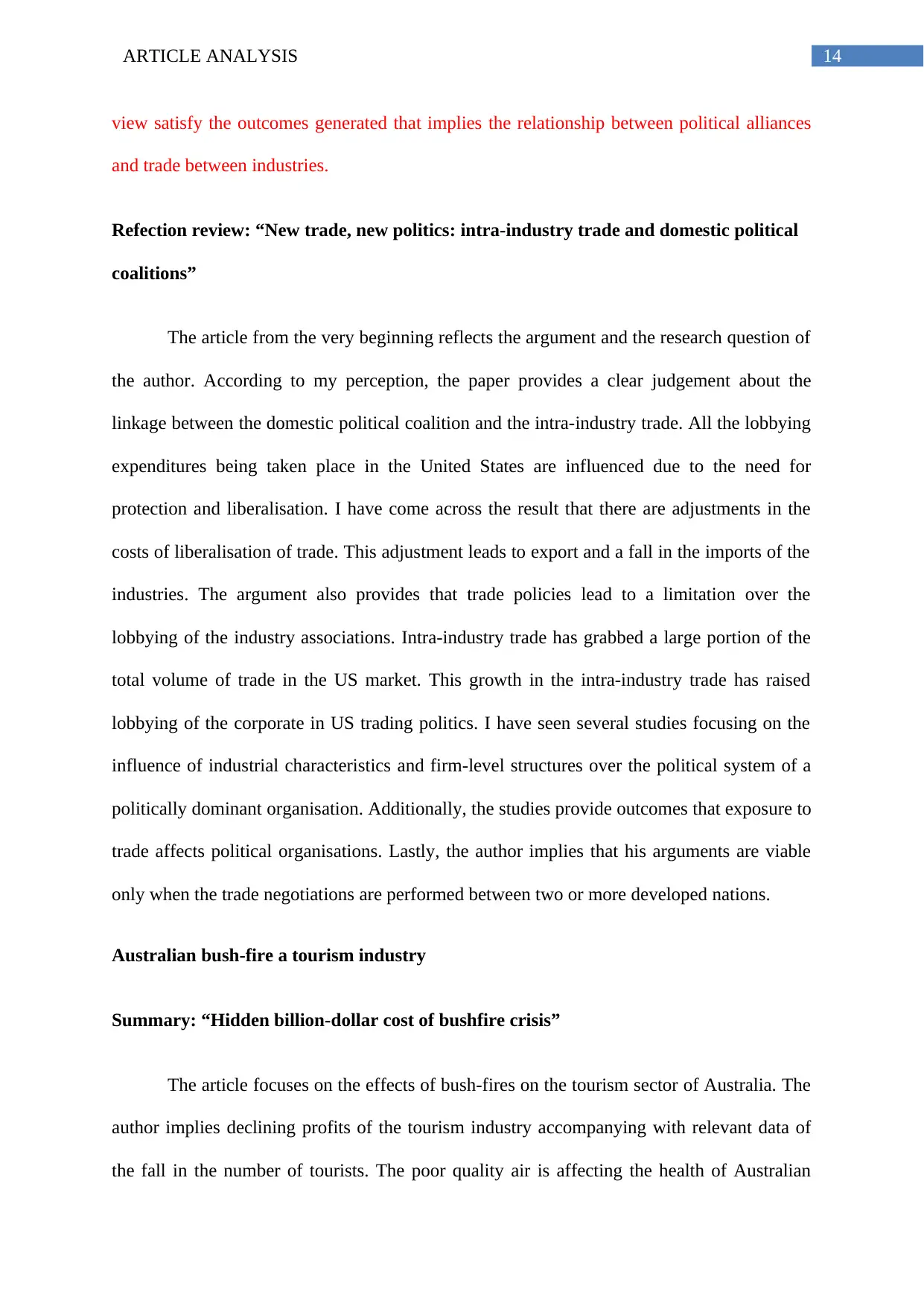
14ARTICLE ANALYSIS
view satisfy the outcomes generated that implies the relationship between political alliances
and trade between industries.
Refection review: “New trade, new politics: intra-industry trade and domestic political
coalitions”
The article from the very beginning reflects the argument and the research question of
the author. According to my perception, the paper provides a clear judgement about the
linkage between the domestic political coalition and the intra-industry trade. All the lobbying
expenditures being taken place in the United States are influenced due to the need for
protection and liberalisation. I have come across the result that there are adjustments in the
costs of liberalisation of trade. This adjustment leads to export and a fall in the imports of the
industries. The argument also provides that trade policies lead to a limitation over the
lobbying of the industry associations. Intra-industry trade has grabbed a large portion of the
total volume of trade in the US market. This growth in the intra-industry trade has raised
lobbying of the corporate in US trading politics. I have seen several studies focusing on the
influence of industrial characteristics and firm-level structures over the political system of a
politically dominant organisation. Additionally, the studies provide outcomes that exposure to
trade affects political organisations. Lastly, the author implies that his arguments are viable
only when the trade negotiations are performed between two or more developed nations.
Australian bush-fire a tourism industry
Summary: “Hidden billion-dollar cost of bushfire crisis”
The article focuses on the effects of bush-fires on the tourism sector of Australia. The
author implies declining profits of the tourism industry accompanying with relevant data of
the fall in the number of tourists. The poor quality air is affecting the health of Australian
view satisfy the outcomes generated that implies the relationship between political alliances
and trade between industries.
Refection review: “New trade, new politics: intra-industry trade and domestic political
coalitions”
The article from the very beginning reflects the argument and the research question of
the author. According to my perception, the paper provides a clear judgement about the
linkage between the domestic political coalition and the intra-industry trade. All the lobbying
expenditures being taken place in the United States are influenced due to the need for
protection and liberalisation. I have come across the result that there are adjustments in the
costs of liberalisation of trade. This adjustment leads to export and a fall in the imports of the
industries. The argument also provides that trade policies lead to a limitation over the
lobbying of the industry associations. Intra-industry trade has grabbed a large portion of the
total volume of trade in the US market. This growth in the intra-industry trade has raised
lobbying of the corporate in US trading politics. I have seen several studies focusing on the
influence of industrial characteristics and firm-level structures over the political system of a
politically dominant organisation. Additionally, the studies provide outcomes that exposure to
trade affects political organisations. Lastly, the author implies that his arguments are viable
only when the trade negotiations are performed between two or more developed nations.
Australian bush-fire a tourism industry
Summary: “Hidden billion-dollar cost of bushfire crisis”
The article focuses on the effects of bush-fires on the tourism sector of Australia. The
author implies declining profits of the tourism industry accompanying with relevant data of
the fall in the number of tourists. The poor quality air is affecting the health of Australian
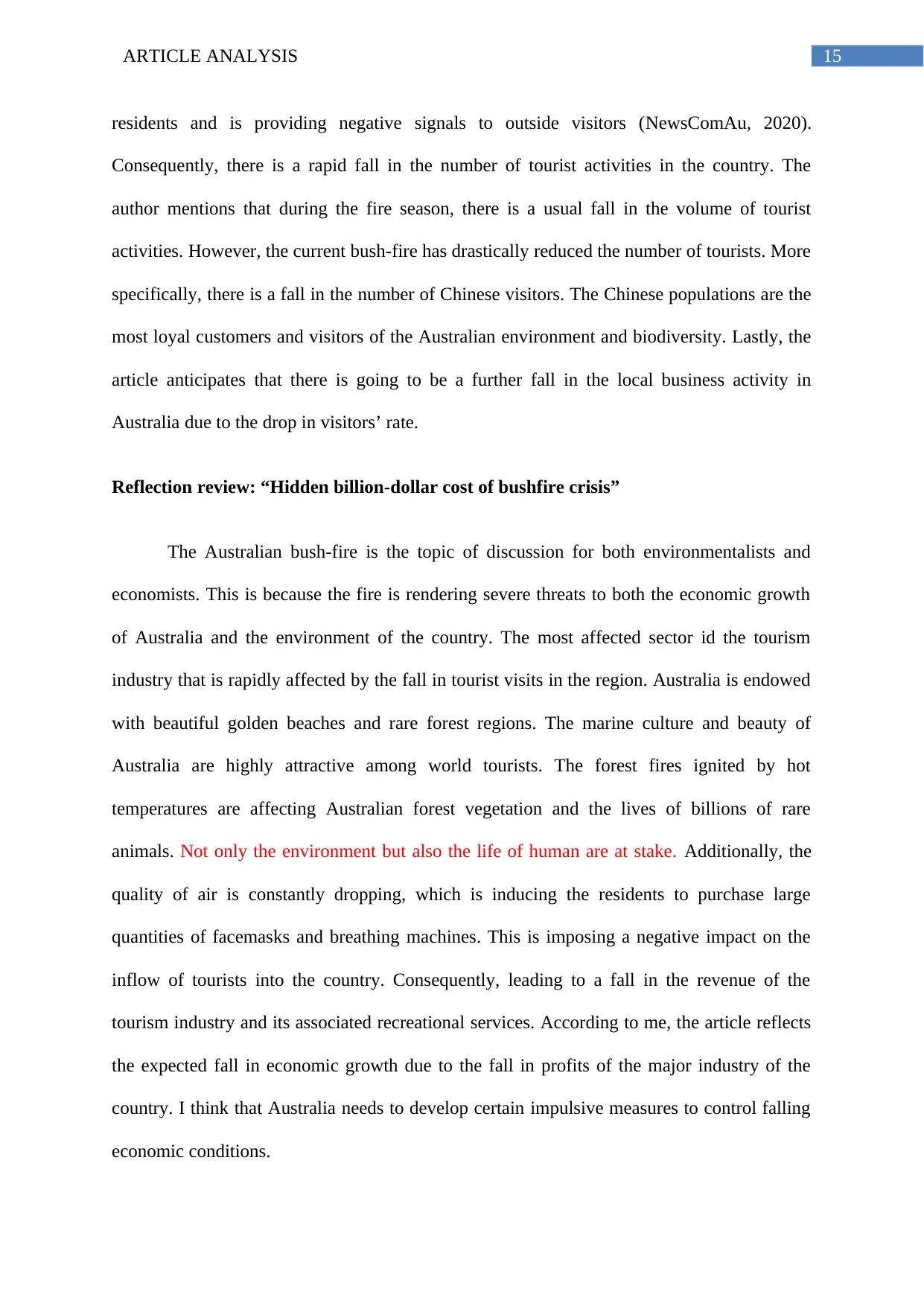
15ARTICLE ANALYSIS
residents and is providing negative signals to outside visitors (NewsComAu, 2020).
Consequently, there is a rapid fall in the number of tourist activities in the country. The
author mentions that during the fire season, there is a usual fall in the volume of tourist
activities. However, the current bush-fire has drastically reduced the number of tourists. More
specifically, there is a fall in the number of Chinese visitors. The Chinese populations are the
most loyal customers and visitors of the Australian environment and biodiversity. Lastly, the
article anticipates that there is going to be a further fall in the local business activity in
Australia due to the drop in visitors’ rate.
Reflection review: “Hidden billion-dollar cost of bushfire crisis”
The Australian bush-fire is the topic of discussion for both environmentalists and
economists. This is because the fire is rendering severe threats to both the economic growth
of Australia and the environment of the country. The most affected sector id the tourism
industry that is rapidly affected by the fall in tourist visits in the region. Australia is endowed
with beautiful golden beaches and rare forest regions. The marine culture and beauty of
Australia are highly attractive among world tourists. The forest fires ignited by hot
temperatures are affecting Australian forest vegetation and the lives of billions of rare
animals. Not only the environment but also the life of human are at stake. Additionally, the
quality of air is constantly dropping, which is inducing the residents to purchase large
quantities of facemasks and breathing machines. This is imposing a negative impact on the
inflow of tourists into the country. Consequently, leading to a fall in the revenue of the
tourism industry and its associated recreational services. According to me, the article reflects
the expected fall in economic growth due to the fall in profits of the major industry of the
country. I think that Australia needs to develop certain impulsive measures to control falling
economic conditions.
residents and is providing negative signals to outside visitors (NewsComAu, 2020).
Consequently, there is a rapid fall in the number of tourist activities in the country. The
author mentions that during the fire season, there is a usual fall in the volume of tourist
activities. However, the current bush-fire has drastically reduced the number of tourists. More
specifically, there is a fall in the number of Chinese visitors. The Chinese populations are the
most loyal customers and visitors of the Australian environment and biodiversity. Lastly, the
article anticipates that there is going to be a further fall in the local business activity in
Australia due to the drop in visitors’ rate.
Reflection review: “Hidden billion-dollar cost of bushfire crisis”
The Australian bush-fire is the topic of discussion for both environmentalists and
economists. This is because the fire is rendering severe threats to both the economic growth
of Australia and the environment of the country. The most affected sector id the tourism
industry that is rapidly affected by the fall in tourist visits in the region. Australia is endowed
with beautiful golden beaches and rare forest regions. The marine culture and beauty of
Australia are highly attractive among world tourists. The forest fires ignited by hot
temperatures are affecting Australian forest vegetation and the lives of billions of rare
animals. Not only the environment but also the life of human are at stake. Additionally, the
quality of air is constantly dropping, which is inducing the residents to purchase large
quantities of facemasks and breathing machines. This is imposing a negative impact on the
inflow of tourists into the country. Consequently, leading to a fall in the revenue of the
tourism industry and its associated recreational services. According to me, the article reflects
the expected fall in economic growth due to the fall in profits of the major industry of the
country. I think that Australia needs to develop certain impulsive measures to control falling
economic conditions.
Secure Best Marks with AI Grader
Need help grading? Try our AI Grader for instant feedback on your assignments.

16ARTICLE ANALYSIS
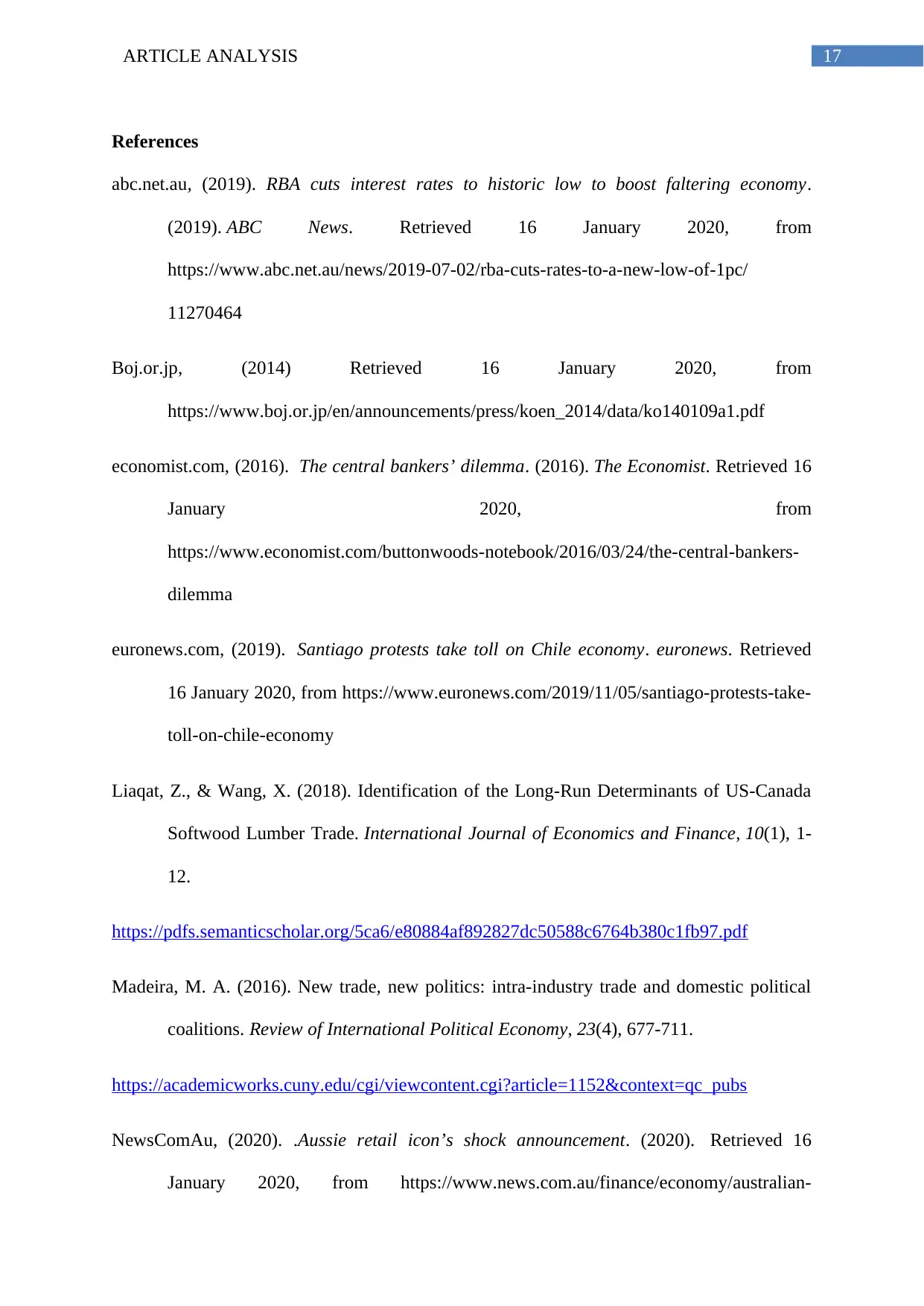
17ARTICLE ANALYSIS
References
abc.net.au, (2019). RBA cuts interest rates to historic low to boost faltering economy.
(2019). ABC News. Retrieved 16 January 2020, from
https://www.abc.net.au/news/2019-07-02/rba-cuts-rates-to-a-new-low-of-1pc/
11270464
Boj.or.jp, (2014) Retrieved 16 January 2020, from
https://www.boj.or.jp/en/announcements/press/koen_2014/data/ko140109a1.pdf
economist.com, (2016). The central bankers’ dilemma. (2016). The Economist. Retrieved 16
January 2020, from
https://www.economist.com/buttonwoods-notebook/2016/03/24/the-central-bankers-
dilemma
euronews.com, (2019). Santiago protests take toll on Chile economy. euronews. Retrieved
16 January 2020, from https://www.euronews.com/2019/11/05/santiago-protests-take-
toll-on-chile-economy
Liaqat, Z., & Wang, X. (2018). Identification of the Long-Run Determinants of US-Canada
Softwood Lumber Trade. International Journal of Economics and Finance, 10(1), 1-
12.
https://pdfs.semanticscholar.org/5ca6/e80884af892827dc50588c6764b380c1fb97.pdf
Madeira, M. A. (2016). New trade, new politics: intra-industry trade and domestic political
coalitions. Review of International Political Economy, 23(4), 677-711.
https://academicworks.cuny.edu/cgi/viewcontent.cgi?article=1152&context=qc_pubs
NewsComAu, (2020). .Aussie retail icon’s shock announcement. (2020). Retrieved 16
January 2020, from https://www.news.com.au/finance/economy/australian-
References
abc.net.au, (2019). RBA cuts interest rates to historic low to boost faltering economy.
(2019). ABC News. Retrieved 16 January 2020, from
https://www.abc.net.au/news/2019-07-02/rba-cuts-rates-to-a-new-low-of-1pc/
11270464
Boj.or.jp, (2014) Retrieved 16 January 2020, from
https://www.boj.or.jp/en/announcements/press/koen_2014/data/ko140109a1.pdf
economist.com, (2016). The central bankers’ dilemma. (2016). The Economist. Retrieved 16
January 2020, from
https://www.economist.com/buttonwoods-notebook/2016/03/24/the-central-bankers-
dilemma
euronews.com, (2019). Santiago protests take toll on Chile economy. euronews. Retrieved
16 January 2020, from https://www.euronews.com/2019/11/05/santiago-protests-take-
toll-on-chile-economy
Liaqat, Z., & Wang, X. (2018). Identification of the Long-Run Determinants of US-Canada
Softwood Lumber Trade. International Journal of Economics and Finance, 10(1), 1-
12.
https://pdfs.semanticscholar.org/5ca6/e80884af892827dc50588c6764b380c1fb97.pdf
Madeira, M. A. (2016). New trade, new politics: intra-industry trade and domestic political
coalitions. Review of International Political Economy, 23(4), 677-711.
https://academicworks.cuny.edu/cgi/viewcontent.cgi?article=1152&context=qc_pubs
NewsComAu, (2020). .Aussie retail icon’s shock announcement. (2020). Retrieved 16
January 2020, from https://www.news.com.au/finance/economy/australian-
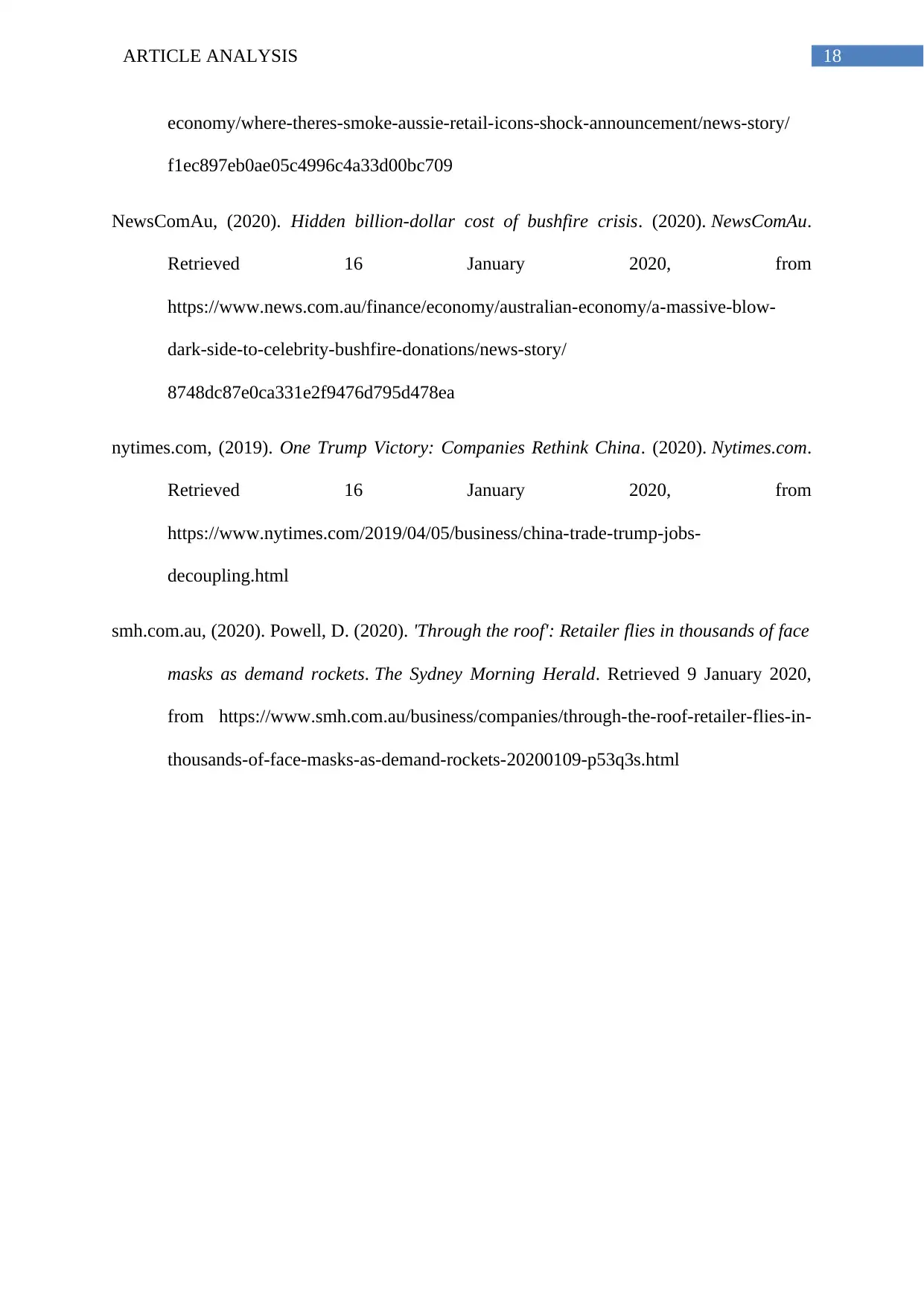
18ARTICLE ANALYSIS
economy/where-theres-smoke-aussie-retail-icons-shock-announcement/news-story/
f1ec897eb0ae05c4996c4a33d00bc709
NewsComAu, (2020). Hidden billion-dollar cost of bushfire crisis. (2020). NewsComAu.
Retrieved 16 January 2020, from
https://www.news.com.au/finance/economy/australian-economy/a-massive-blow-
dark-side-to-celebrity-bushfire-donations/news-story/
8748dc87e0ca331e2f9476d795d478ea
nytimes.com, (2019). One Trump Victory: Companies Rethink China. (2020). Nytimes.com.
Retrieved 16 January 2020, from
https://www.nytimes.com/2019/04/05/business/china-trade-trump-jobs-
decoupling.html
smh.com.au, (2020). Powell, D. (2020). 'Through the roof': Retailer flies in thousands of face
masks as demand rockets. The Sydney Morning Herald. Retrieved 9 January 2020,
from https://www.smh.com.au/business/companies/through-the-roof-retailer-flies-in-
thousands-of-face-masks-as-demand-rockets-20200109-p53q3s.html
economy/where-theres-smoke-aussie-retail-icons-shock-announcement/news-story/
f1ec897eb0ae05c4996c4a33d00bc709
NewsComAu, (2020). Hidden billion-dollar cost of bushfire crisis. (2020). NewsComAu.
Retrieved 16 January 2020, from
https://www.news.com.au/finance/economy/australian-economy/a-massive-blow-
dark-side-to-celebrity-bushfire-donations/news-story/
8748dc87e0ca331e2f9476d795d478ea
nytimes.com, (2019). One Trump Victory: Companies Rethink China. (2020). Nytimes.com.
Retrieved 16 January 2020, from
https://www.nytimes.com/2019/04/05/business/china-trade-trump-jobs-
decoupling.html
smh.com.au, (2020). Powell, D. (2020). 'Through the roof': Retailer flies in thousands of face
masks as demand rockets. The Sydney Morning Herald. Retrieved 9 January 2020,
from https://www.smh.com.au/business/companies/through-the-roof-retailer-flies-in-
thousands-of-face-masks-as-demand-rockets-20200109-p53q3s.html
1 out of 19
Your All-in-One AI-Powered Toolkit for Academic Success.
+13062052269
info@desklib.com
Available 24*7 on WhatsApp / Email
![[object Object]](/_next/static/media/star-bottom.7253800d.svg)
Unlock your academic potential
© 2024 | Zucol Services PVT LTD | All rights reserved.